ALL ABOUT CERTIFICATION












Whichever you prefer, we’ve got your mix. After all, “JIFFY” has been the name in corn muffin mix for more than 70 years. With our complete Sweet or Southern Cornbread and Muffin mixes, you can bake up either (or both) in a “JIFFY”… Foodservice that is.



We explore one of the hallmarks of ACF membership. Plus, a look at the new format for the Certified Master Chef exam.
Restaurants have primed their outdoor spaces to take on alfresco dining this season as a safe — and enjoyable — option.
14 Management
18
Chefs inadvertently have enhanced teamwork in the kitchen during these tough times. Find out how.
In revisiting garde manger, the workhorse station of any kitchen, opportunities for creativity abound.
Fresh for spring and summer, ceviche — in classic and modern form — never fails to satisfy.
The humble éclair seems simple, yet its construction is anything but. Here’s how some pastry chefs are reimagining the elegant pastry.
28
Chef Robert Velarde, CEC, prepares a classic rack of lamb dish, as well as a modern, globally inspired take featuring baharat, a Middle Eastern spice blend.
As the plant-forward movement continues, chefs are finding even more creative ways to cut back on meat and introduce more vegetables.
48
Country club chefs talk about how the pandemic has impacted their business and how they have adapted to overcome challenges.
Editor-in-Chief
Amelia Levin
Creative Services Manager
David Ristau
Graphic Designer
Armando Mitra
Advertising and Event Sales
Eric Gershowitz
Jeff Rhodes
Director of Marketing and Communications


Alan Sterling
180 Center Place Way • St. Augustine, FL 32095 (800) 624-9458 (904) 824-4468 Fax: (904) 940-0741 ncr@acfchefs.net ACFSales@mci-group.com www.acfchefs.org
Board of Directors
President
Thomas Macrina, CEC®, CCA®, AAC®
National Secretary
Mark Wright, CEC, AAC
National Treasurer
James Taylor, CEC, AAC, MBA
American Academy of Chefs Chair
Americo “Rico” DiFronzo, CEC, CCA, AAC
Vice President Central Region
Steven Jilleba, CMC®, CCE®, AAC
Vice President Northeast Region
Barry R. Young, CEC, CCE, AAC
Vice President Southeast Region
Kimberly Brock Brown, CEPC®, CCA, AAC
Vice President Western Region
Robert W. Phillips, CEC, CCA, AAC
Executive Director
Heidi Cramb
The National Culinary Review® (ISSN 0747-7716), May/June 2021, Volume 45, Number 3, is owned by the American Culinary Federation, Inc. (ACF) and is produced 6 times a year by ACF, located at 180 Center Place Way, St. Augustine, FL 32095. A digital subscription to the National Culinary Review® is included with ACF membership dues; print subscriptions are available to ACF members for $25 per year, domestic; nonmember subscriptions are $40. Material from the National Culinary Review®, in whole or in part, may not be reproduced without written permission. All views and opinions expressed in the National Culinary Review® are those of the author and do not necessarily reflect the views and opinions of the officers or members of ACF. Changes of mailing address should be sent to ACF’s national office: 180 Center Place Way, St. Augustine, FL 32095; (800) 624-9458; Fax (904) 940-0741.
The National Culinary Review® is mailed and periodical postage is paid at St. Augustine, Fla., and additional post offices.
POSTMASTER: Send address changes to the National Culinary Review®, 180 Center Place Way, St. Augustine, FL 32095.

Spring has sprung, and as I look to the summer, you know what I’m going to say: I am beyond excited for the 2021 ACF National Convention in Orlando!
We’re waking up not only from a long winter but also from a long hibernation — literally. Most of us have spent more than a year apart and mostly grounded at home. If you’re like me, you’re itching to get out and see your friends and peers.
That’s why we’re thrilled to announce the beginnings of an amazing lineup of speakers and presenters that continues to grow by the day. This year’s event, held Aug. 2-5 at the Orlando World Center Marriott, will also host the largest competition stage in ACF convention history, with 10 kitchens and chefs of all levels showcasing their talents and techniques.
For the educational segment, we’ll enjoy a wide range of presentations, from timely topics like navigating a post-pandemic world and exploring alternative business opportunities, to a look at culinary medicine and the new frontier of fusion, creative ways to promote a sustainable future in food, today’s food trends and more.
As always, there will be plenty of food (and drink) demonstrations, including those covering salsas and sangria, cooking with cannabis and advanced pastry techniques, and an interactive wine and food pairing session, just to name a few. A HUGE thank you to all of our ACF volunteers, sponsors and partners who have been working so hard to put together these sessions and the competition stage. We couldn’t do any of this without you.
I’d also like to thank the hotel team with whom we worked closely to implement safety protocols for the in-person event, as well as offer a few fun perks for hotel guests. Those perks include dining credits; discounts on room rates, retail and spa services; extra shuttle passes to Disney parks; and even complimentary mini golf tickets for up to four people. Book now — rooms always fill up fast! If you are not able to attend the in-person event this year, we will be livestreaming and recording selected portions of the convention for you to enjoy remotely.
While we count down the days until the convention begins, we’ve packed this issue with plenty of content for your reading pleasure. Learn about the history and benefits of ACF certification; what you can do to set up a safe, outdoor operation; what’s trending in the plant-based world and more.
Happy spring (and summer) and see you soon,
Thomas “Tom” Macrina, CEC, CCA, AAC National President American Culinary Federation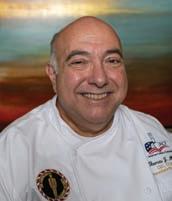
Ya llegó la primavera, y de cara al verano, saben lo que voy a decir: ¡Estoy más que emocionado por la Convención Nacional de la ACF 2021 en Orlando!
Nos estamos despertando no solo tras un largo invierno, sino también tras una larga hibernación, literalmente. La mayoría de nosotros hemos pasado más de un año aislados y en nuestras casas. Si son como yo, entonces tendrán ganas de salir y ver a sus amigos y compañeros.
Es por eso que estamos encantados de anunciar el comienzo de una increíble lista de oradores y presentadores para este año que continúa creciendo día a día. El evento de este año, que se llevará a cabo del 2 al 5 de agosto en el Orlando World Center Marriott, también albergará el escenario de competencia más grande en la historia de la convención de la ACF, con 10 cocinas y chefs de todos los niveles que harán gala de sus talentos y técnicas.
En cuanto al segmento educativo, disfrutaremos de una amplia gama de temas, desde cuestiones actuales como transitar la realidad después de la pandemia y explorar oportunidades comerciales alternativas, hasta la medicina culinaria y la nueva frontera de la fusión; formas creativas de promover un futuro sostenible en materia de alimentación; las tendencias alimentarias actuales y muchas cosas más.
Como siempre, habrá muchas degustaciones de comida (y bebida), desde salsas y sangría, cocina con cannabis y técnicas avanzadas de pastelería, hasta una sesión interactiva de maridaje de vinos y platos, solo por nombrar algunas. Quiero expresar un ENORME agradecimiento a todos nuestros voluntarios, patrocinadores y socios de la ACF que han trabajado tanto para organizar estas sesiones y el escenario de la competencia. No podríamos hacer nada de esto sin ustedes.
También me gustaría agradecer al equipo del hotel con el que trabajamos en estrecha colaboración para implementar protocolos de seguridad para el evento presencial, así como ofrecer algunos beneficios divertidos para los huéspedes del hotel, entre ellos créditos para cenas; tarifas con descuento, servicios minoristas y de spa; pases de transporte adicionales para los parques de Disney e incluso boletos de minigolf de cortesía para hasta cuatro personas. Hagan su reserva ahora: ¡Las habitaciones siempre se llenan rápido! Si no pueden asistir al evento presencial este año, estaremos transmitiendo en vivo y grabando partes seleccionadas de la convención para que puedan disfrutarla de forma remota.

A medida que contamos los días para que llegue la convención, hemos colmado esta edición de contenidos para que disfruten. Conozcan la historia y los beneficios de la certificación ACF; lo que pueden hacer para organizar una actividad segura al aire libre; cuáles son las tendencias en el mundo de las plantas y más.
Feliz primavera (y verano), nos vemos pronto.
Visit WeAreChefs.com, the official content hub for the American Culinary Federation, to read online exclusive articles, including industry trends, interviews, COVID-19 coverage, recipes and more.
The ACF ChefsForum Webinar Series has been a smashing success, with high attendance each session. Enjoy everything from a discussion about Modernist Cuisine and a live tour of The Cooking Lab in Bellevue, Washington, to an educational session on cooking with cannabis to demos on produce carving and beekeeping — with more planned for the coming months. Missed a webinar? All recorded sessions are available online.
In this ongoing series, we take a deep dive into the backstories and preparation methods of prized dishes from different chefs. Recent stories feature a catfish and crab stew developed by Chef Kevin Mitchell, CEC, and inspired by the historic cuisine of the Carolinas, as well as a goat cheese-crusted rack of lamb by Chef Eric Gillish, just in time for the spring.
We’ve got some ideas to help you plan menus for Mother’s Day, Memorial Day, Father’s Day, the Fourth of July and other upcoming holidays.
NCR’s ACF Chef Profile column regularly features member success stories, but there is so much more to share outside of the magazine’s bimonthly issues. Visit WeAreChefs.com to read more about your fellow members and their work and careers.
The Culinary Insider, the ACF’s bi-weekly newsletter, offers timely information about events, certification, member discounts, the newest blog posts, competitions, contests and much more. Sign up at acfchefs.org/tci.
Follow the ACF on your favorite social media platforms:

@acfchefs
@acfchefs
@acf_chefs
@acfchefs American Culinary Federation
What are you most looking forward to doing this summer? Bonus points if you answer, “Going to the ACF National Convention!”
Tweet us your answer using the hashtag #ACFasks and we’ll retweet our favorites.
Check out ACF’s Online Learning Center. There you’ll find NCR quizzes, videos of educational sessions from ACF events, practice exams for certification and more. Visit learn.acfchefs.org to get started.











The 2021 ACF National Convention will take place Aug. 2-5 at Orlando World Center Marriott, with the Board of Governors meeting and the 49th annual American Academy of Chefs (AAC) induction dinner to be held Aug. 1. Register at acfchefs.org/events.
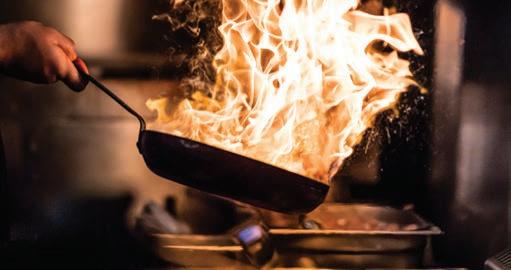
Don’t miss this chance to attend one of the most highly anticipated annual gatherings of chefs, students and foodservice professionals in the country, with world-class presenters and demos, 10 competition kitchens and more than 100 sponsors displaying the latest and greatest when it comes to food products, equipment and more. Full registration includes a program badge with access to all one-hour seminars and demos, as well as the general session, trade show, networking breaks and grab-and-go box meals.
when and whether to hold in-person events, and to develop proper safety protocols for those gatherings. We have worked diligently with Orlando World Center Marriott and conference planning teams to develop and implement several protocols to ensure the safety of our attendees, staff and presenters — including requiring masks, separating doors for incoming and outgoing traffic and implementing glass barriers, social distancing decals and ample sanitation stations. For more information on the convention safety protocols, visit acfchefs.org.
Full registrations will receive 23 Continuing Education Hours for attending the convention. The educational component of this year’s convention promises an exciting lineup of speakers and presentations on a wide array of topics, including:
• Preparing for a post-COVID pivot with life coach Duane Brown
• Culinary medicine and the “new frontier of fusion” with Chef Michael Fenster, M.D.
• Best chef-preneurial practices for chef-owned food and beverage ventures with culinary instructor Chef Fred Tiess, CEC, CCA
• Creative ways to reduce food waste and promote a sustainable future for foodservice with Chef Hari Pulapaka
• L everaging opportunities in the “new normal” with trends expert Maeve Webster
“After such a challenging past year, plus and so much time apart, we are so excited to reconnect with our fellow members and peers,” says Chef Tom Macrina, CEC, CCA, AAC, ACF president. “This is truly going to be a special event, not just because we haven’t seen each other in person for so long, but because of the remarkable lineup of presenters.”
Throughout the past year, the ACF team has kept a close eye on the developing COVID-19 situation, carefully following both CDC guidelines and feedback from ACF members to determine
There are also many culinary demonstrations scheduled for this year’s convention, including a study of regional Mexican salsas and sangria; expert advice on cooking with cannabis; a demonstration of advanced pastry techniques; and an interactive wine and food pairing, to name a few.
This year’s convention will feature a larger competition setup than ever before, with 10 kitchens. More details will be announced soon.
“The competitions are always such a draw at the ACF National Convention,” says Chef Steve Jilleba, CMC, CCE, AAC, competition liaison for the ACF board, competition judge and an ACF Culinary Team USA advisor. “Our student teams are tremendous and an amazing part of the talent that comes out of these events. It’s a draw for people to watch chefs at all levels go up against their peers to produce amazing dishes and show off their skills and techniques.”
Orlando World Center Marriott is offering ACF attendees a discounted rate of $177 per night (not including tax and other fees). Reservations must be made by July 12 in order to receive this discounted rate. Visit acfchefs.org/Convention for more information and to book online, or call 844-202-2001 for registrations.
The American Academy of Chefs 49th Annual Induction Dinner will be held on Sunday, Aug. 1, with a reception beginning at 6 p.m. Tickets are on sale for $175.00 per person. Seating is limited. Open to AAC Fellows only. Buy tickets at acfchefs.org/events
For those who are unable to attend the in-person event, this year’s convention features an online component. Select portions of the main stage and competition kitchens will be recorded and streamed simultaneously. Visit acfchefs.org for developing details on the virtual option.
“I obtained a dream job [as a cook in the pastry department] at Noble Bakery, a wholesale bakery that also does direct retail through farmers markets and a small eatery here in the greater Phoenix area. When I graduated from the culinary program at Scottsdale
Community College, Chef Dina Altieri (CEC, CCE, CHE), the chapter head of ACF here in Arizona, was very supportive and inclusive. She reached out often with opportunities for us to engage with ACF, whether through virtual meetings or other available events. When the pastry chef at Noble reached out to a former colleague at ACF, Dina knew immediately that this was a perfect position for me and reached out that same day. By that afternoon, I had an interview scheduled, which led to a stage, which resulted in my employment. If not for my relationship with Dina and her encouragement to be involved on a deeper level, this opportunity would have passed by me. I'm very grateful. I choose to become an ACF member because I see the value in knowing and learning from people who have been there before me. As a new culinary graduate but an older person who made a career change to do something I love, I am eager to learn as much as possible in the shortest amount of time. What better way than to network with those who have walked the hard yards and have knowledge to share? I'm learning that the culinary world, while wide-ranging, is small, and I will cross paths often with people as they move from place to place. Additionally, should I leave this area, I know that another chapter with knowledgeable people already in place is waiting for me when I get to where I'm going.”
-Kari-Lynn Kauffman, new member since fall 2020

Motivate your team and grow your business by offering ACF certification to your employees. Employing an ACF-certified chef ensures a benchmark of excellence to customers by demonstrating professional standards in culinary skills and knowledge; motivates employees to improve professionally and participate in professional development; improves retention; complements existing professional development programs; provides results; and enhances performance and productivity, which positively impacts the bottom line. ACF's Certification Concierge Service is a customizable program designed to meet your company's goals and vision while maintaining certification standards. To be eligible, you must commit to a minimum of 10 certification applicants within a 12-month period. For more information, send an email to certify@acfchefs.net.
Show your ACF pride! Visit our online store to check out items such as shirts, caps, cutting boards, skillets and more, all with the ACF logo proudly displayed. Visit acfchefs.org for more information and to shop.
Find your next great opportunity at the ACF Career Center. Visit jobs. acfchefs.org and post your resume, set up job alerts and even improve your resume with a free review by a resume expert.

The What to Eat When Cookbook
(National Geographic, 2020)
By Michael F. Roizen, M.D., Michael Crupain, M.D., M.P.H., and Chef Jim Perko, Sr., CEC, AACIn this sequel to the groundbreaking lifestyle book “What to Eat When,” Dr. Roizen and Dr. Crupain team up with Chef Perko, an ACF member and executive chef at the Cleveland Clinic, to serve up more than 135 recipes that show how to add moisture without fat, sweetness without sugar, savory density without meat and other elements of their strategic cooking and eating plan for maximum health. From butternut squash dumplings to linguine with mushroom “bacon,” this book features many vegetable-forward recipes, chicken and fish dishes as well as guilt-free desserts that will power up your day and potentially extend your life by years.
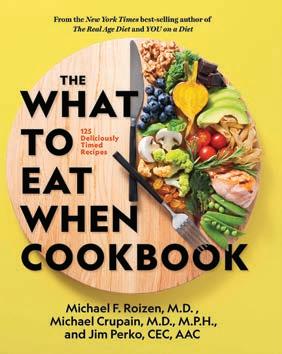
We regret to inform you that Kay Amy Orde, who served as editor of the National Culinary Review for nearly 20 years — from 2001 to her retirement in 2018 — passed away peacefully and surrounded by her family on March 19, after a long illness. She was 77 years old. Born in Swansea, Wales, to Charles and Irene Brooks, Orde grew up in Totternhoe, Bedfordshire, England, before coming to the United States in 1963 to work as a nanny in Minneapolis. From there, she lived in Delaware, Connecticut, Arizona and Indiana before settling in Durham, North Carolina. Twenty-five years after finishing school in England, Orde earned a bachelor’s degree in journalism from the University of North Carolina at Chapel Hill. She took on reporting positions for the Chapel Hill News and the Durham Morning Herald and earned a master’s degree from North Carolina State University. In 1998, she moved one last time, to St. Augustine, Florida, and maried her longtime best friend, Lewis Orde. Orde once said that serving as editor of NCR was her “favorite job of all time.” Many ACF chefs have expressed their gratitude for Orde, who helped them in their career and connected them with others through her work on the magazine. In 2014, Orde was awarded the Betty Bastion Outstanding Service Award, which is presented annually by the International Food Editorial Council (IFEC) to celebrate a member who has provided extraordinary service to the association and the foodservice communications field, and who stands out as a knowledgeable and generous professional. Orde is survived by her husband, two daughters, three grandchildren, sister and everyone whose lives she touched with her warmth, kindness and generosity.

Accelerate your career with ACF Mentor Match. Find the expert guidance, wisdom and support from another ACF Member and watch your career take flight. Enroll now and then use the directory to find the perfect match by logging into Chef's Table, our online member community at chefs-table.acfchefs.org/home
Make renewing your ACF Membership easier. Simply select FlexPay when renewing online and set up your desired payment frequency, including a 12-month option. Visit acfchefs.org/ACF/Membership or call the ACF Membership Team at (904) 484-0229, to get started.
Under the Chef & Child Initiative, ACFEF is offering ACF chefs and chapters grant funding to support nutrition outreach activities in their communities. The next grant deadline is Aug. 31. For more information and to apply , visit acfchefs. org/ACF/Partnerships .
Congratulations to Chef Brian Peffley, CEPC, CCE, AAC, pastry instructor at Lebanon County Career and Technological Center in Lebanon, Pennsylvania, who was selected by the board of directors of SkillsUSA Inc., to receive the SkillsUSA Outstanding Career and Technical Educator Award.



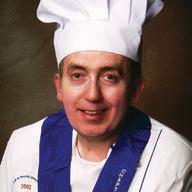
Chef Fred Griesbach, CEC, AAC, chef at Cooking World Culinary Services in Stevens Point, Wisconsin, was awarded a regional award for Best of the Back of the House by the Wisconsin Restaurant Association at an annual awards gala this spring. Criteria for the award include attention to detail, calm under pressure, a strong work ethic and leadership skills. The Back of the House winners show inspiring commitment to the foodservice industry and to the success of the restaurants where they work. Chef Griesbach also won the 2020 Citizen of the Year award, presented by the Heart of Wisconsin Chamber of Commerce.
The ACF Central Florida Chapter named Bryan Frick, CEC, AAC, its 2020 Chef of the Year. A member of the chapter since 1990, Chef Frick has spent 30 years volunteering his time for the betterment of the local and greater culinary community. He previously won the chapter’s Chef of the Year award in 1996. Since then, he also has been recognized with president’s appreciation awards, the chapter’s Achievement in Culinary Excellence (ACE) award, a President’s Achievement Award and a National Presidential Coin from Chef Michael Ty, CEC, AAC. Chef Frick has chaired events for Give Kids the World Village for more than 20 years. He also has chaired the chapter’s participation in other community fundraisers.
Chef Samuel Spencer, president of the ACF Gulf Coast Culinary Association, announced the awarding of the chapter’s annual scholarship to Blessing Chichah, who is originally from Warri, Nigeria, and is currently a culinary arts student at Bishop State Community College in Mobile, Alabama. “This scholarship means so much to me and has allowed me to take classes and [fulfill my tuition],” says Chef Chichah, who enjoys presenting dishes from her heritage, such as jollof rice and beef dodo. “This is the first scholarship I have ever gotten in my life, and I am so grateful.”




When the coronavirus pandemic swept the world and nation last year, the restaurant industry was one of the sectors hit hardest. Out front, dining rooms were closed. Takeout orders increased, and some restaurants transitioned to delivery only.
Behind the scenes, kitchen teams made the adjustments necessary to keep customers and teammates safe, to train new hires and to keep the wheels turning. With 2.5 million cooks employed in 2019 — and the number of jobs in this profession projected to grow 10% by 2029, according to the U.S. Department of Labor — it’s more important than ever to focus time and energy on the teams that run America’s kitchens.
For Chef Brian Beland, CMC, executive chef and director of food and beverage at the Country Club of Detroit, the pandemic ultimately helped make his team stronger. “Every person on the team made sacrifices this past year to support the team,” he says. “They sacrificed hours, covered for each other and truly put the team above the individual to get through.” Meanwhile, Chef Beland says, the pandemic gave employees extra time to cross-train, refocus and take a closer look at the club’s operational model and how it could be improved.
Chef Kevin Walker, CMC, executive chef at Ansley Golf Club in Atlanta, says the past year has brought kitchen superstars to the forefront. “Those who may have been flying under the radar have really stepped up,” he says. “It showed us the potential in people that maybe we didn’t see before.”
Pandemic or not, there are proven techniques that every kitchen leader can use to help strengthen and nurture an everchanging staff.
Everything that happens in a restaurant kitchen should begin with a coherent message from the top that is followed through with actions, according to Chef Walker. Leading by example shows the staff that the executive chef is on the same team, understands
what employees are going through and can help if someone is genuinely struggling. “The team needs to feel like we’re all in this together,” Chef Walker says. “Today is more important than tomorrow.”
Chef Beland agrees that a strong leader is a key to success. “The leader needs to create the vision for a team and continually demonstrate that vision through daily actions and decisionmaking,” he says. “The team needs to be built with individual participants that want to be a part of, and work hard for, that same experience.”
Once a team is created, teamwork needs to be planted, nurtured, developed and continually fostered, according to Chef Beland, who says true teamwork takes an unwavering commitment and professional maturity. “It needs to be on all day, every day, all year, year over year,” he says.
And while it can be difficult to remain ‘on’ all the time, Chef Walker says it can take even more to keep individuals focused on team decision-making and the big picture. “It’s natural to focus on oneself, to get caught up in difficult times and the stress of the daily push,” he says. “At some point, someone, or the team, has to decide to step up and strive for team and service excellence above all else.”
Some chefs may receive training in large chain restaurants that only permit chefs to work at one station until the chef has mastered it. However, Chef Walker says cross-training chefs to learn every station is essential if you expect to build a strong kitchen team. “When a chef asks me why I’m moving them off their station, I tell them it’s because I want them to learn and become an even more valuable team member,” he says. “They’re still getting paid the same amount, and they’ll have more skills when they leave.”
More than goals, every team needs to adhere to specific guidelines and parameters. “Very rarely do I fire anybody,” Chef Walker says. “Most people will rise to the occasion if you challenge them; others who don’t, will leave.”
The pandemic also created new rules and protocols for kitchens via mask mandates, temperature checks and new
cooking and cleaning routines. “I think that as much as people want to be free spirits, they also like working within structure and order,” Chef Walker says. “We have a heightened sensitivity because of COVID-19. If someone sends a steak back now for being undercooked, we take it to the dish station, wash our hands and make a new one.”
Every team wants to be successful. Because chefs are inherently creative, many have great ideas and resolutions for existing problems. “Take the time to listen and engage with your team,” Chef Beland says. “They may be able to identify real issues and provide solutions.”
Meanwhile, see how you can set up your team for success by providing small wins when people meet and exceed the standards and expectations you’ve set. Chef Beland says that ‘wins’ could be anything from giving team members their requested time off, to investing in equipment that makes their jobs easier.
Building a strong, reliable team can’t happen overnight. “It’s about getting the buy-in and showing them that you care and are trying to help,” Chef Walker says. “It takes time and a lot of work and energy. But when you get there, it’s worth it.”
Every kitchen and every team is unique. “What works with one team or person will likely not work with another,” Chef Beland says. “Be open-minded, be consistent and keep pushing for excellence.”


The ACF Tampa Bay chapter celebrates a long history of active membership, even during the COVID-19 pandemic. // By Amelia Levin
In 2020, even amidst a global pandemic, the ACF Tampa Bay chapter had quite a few accomplishments. In February, just before the pandemic hit, seven Tampa Bay members went to the IKA Culinary Olympics as part of the ACF Culinary Team USA. That group included Chef Rene Marquis, CEC, CCE, CCA, AAC, former chapter president and business manager for the team; Chef Vanessa Marquis, CEC, who took the gavel from her husband as chapter president in January; Chef Kevin Maier, sous chef; Chefs Michael Thrash, CEC, and Jeff Blanchet, CEC, logisticians; and Chefs Zoltan Vajna, CEC, and Barry Reid, team support personnel.
Even amid the pandemic, the chapter remained as active as possible, hosting monthly virtual meetings through Zoom from May to August before switching to in-person sessions (with mask mandates and social distancing) every month thereafter, continuing into 2021.
Chef Rene Marquis, who was chapter president at the time, sent messages to members, offering a lifeline of support, and invited non-members to attend Zoom and in-person meetings to connect with other industry professionals.
At the peak of the pandemic in July, when so many families were in need of food and basic necessities, the Tampa Bay chapter teamed up with Metropolitan Ministries in Tampa, a longtime partner organization, to help box and distribute meals through the USDA’s Farmers to Families program. In the first week alone, the team distributed 1,440 family meals — totaling a whopping 14,400 pounds of
food. The chapter maintained those numbers, totaling 21,600 meals (216,000 pounds of food) over the course of 15 weeks. The partnership came about through ACF member connections with FiveStar Gourmet Foods, a produce supplier. As a result, the meal boxes didn’t just include dried goods. Families were given healthy, ready-to-eat produce like carrots, broccoli blends, salad mixes and sliced fruit — foods that, at one point, were hard to come by due to a major supply chain shortage caused by the pandemic. Chapter volunteers literally packed up a tractortrailer worth of meals each week and drove the truck to shelters, soup kitchens and other touch points in the community.
In September, the Tampa Bay chapter held a virtual certification practical examination for two sous chefs by using cameras and Skype to essentially broadcast the setup in the kitchen of a local hotel, and then run food to proctors in a hotel room. Both Chef Alex Ritchie and Chef Racheal Palmer, met the standards for Certified Sous Chef.
Also in September, the chapter held its annual awards ceremony. The event was initially set to take place in the outdoor parking lot of a local foodservice equipment company headquarters, but bad weather required the group to move partially indoors to the company’s massive warehouse with all doors opened. Food was given to the attendees in the form of gourmet box lunches; the entire event was free for chapter members. During the ceremony, which typically honors 10 culinarians with various awards, the chapter also presented three culinary students with scholarships totaling $5,000.
During the holiday season in December, the chapter teamed up with A Kid’s Place of Tampa Bay, a local orphanage for 60 children, to donate 15,000 pounds of food from US Foods, Simplot and Smithfield, as well as unwrapped gifts. The chapter matched $1,000 in donations to provide a total of $2,000 in gift cards that A Kid’s Place staff can use to take the children out for dinner, ice cream and other special occasions. As a thank you, uniform outfitter Newchef gave a chef's coat to each chapter member who donated.
In March of this year, the Tampa Bay chapter hosted a sold-out Student Scholarship Fundraiser Dinner on the patio at The Bay Club at Westshore Yacht Club, with proceeds benefiting local culinary school students. Participating
chapter members put on 18 individual chef tasting stations. “The event was no cost to the chapter,” Chef Rene Marquis says. “Our chefs only donated their time, and all of the food and even disposables were provided. We were able to raise $10,000 for student scholarships.”

Senior Chef Vince Blancato, continues to serve as the chapter’s Chef & Child Initiative chair. On Oct. 16, he spoke to third grade classes at Gulfside Elementary School in Holiday, Florida, about the importance of healthy eating and the nutritional values of each of the five food color groups (blue/purple, green, white, red, yellow/orange). Also on the Chef & Child Initiative committee are senior Chefs Ray Benton and Marguerite Jireau, Chef Vanessa Marquis and Chef Anne White, who last year received the chapter’s coveted George Pastor award. Chef White also volunteers at GiGi's Playhouse, a nonprofit that provides culinary arts education for students with Down syndrome.
It is through the chapter’s long line of philanthropic and volunteer activities, both on the part of individual members and the group as a whole, that ACF Tampa Bay stays true to its mission. The goal is to advance the culinary profession and culinary awareness through education, member certification and close interaction with local organizations.
“Our mission is to not only reach out and help those in our industry with education, certifications and competition guidance, but to assist the Tampa Bay community by doing what we know how to do best — reaching them through food,” Chef Vanessa Marquis says. “We will continue to mentor our student culinarians; provide scholarships; feed veterans, the homeless and orphans; prepare children for a healthy life and more. Our value as a chapter is measured by how much we can give back.”
Chef Rene Marquis profoundly thanks the chapter’s longtime vendors and other partner organizations for donating food, supplies, space and more to host events and educational sessions throughout the years, at little or no cost
to members. “We are grateful for these partnerships,” he says.
Individual chapter members have remained heavily active in volunteer work with ACF. Chef Rene Marquis, a retired U.S. Army veteran, also serves as military regional director for the American Academy of Chefs, as well as certification chair for the ACF Tampa Bay chapter. This year, two Tampa Bay chefs are up for induction into the 2021 class of American Academy of Chefs, including Chef Thrash, who serves as chair of the chapter’s bylaws, policy and procedures committee, and Chef Vanessa Marquis.
“Although the last 12 months have been uncertain and stressful for all, we do know this: ACF Tampa Bay is family,” Chef Vanessa Marquis says. “We can call on each other for help, a shoulder to cry on, to share ideas and for guidance. The chapter has been the only sense of normalcy during this pandemic, and we will continue to be here after this madness has passed. We will adapt, as chefs always do, and will make the most of what is given to us.”

Many aspects of the modern food industry are rooted in garde manger. Originally, the term, which was coined during the Middle Ages, referred to a cool, underground room in noble residences where food was prepared and stored. As restaurants became a thing, the definition of garde manger evolved, especially upon the introduction of refrigeration. Garde manger came to have a dual meaning, first as a designated area in the kitchen that was kept at a cooler temperature and used specifically for preparing and storing cold foods. The term also was applied to the chefs who preside over that area.
Today, garde manger chefs wear many hats and are responsible for everything from appetizer preparation to service to creating complex, splashy spreads for banquets and buffets. Confounding matters, many restaurants refer to the garde manger station as the pantry station, where appetizers are prepared. But let’s be clear: Whatever you call it, this chef’s job is far from easy. It’s one of the kitchen’s most involved roles, given the proliferation of ingredients that are used to make a large, diverse roster of
cold (and even hot) fare. With garde manger dishes often outnumbering entrées on a restaurant menu, timing and organization are paramount.
As for those expansive event spreads, they’ve evolved over time and, not surprisingly, since the onset of COVID-19. Small individual plates often stand in for the plate-your-own
approach, and on-demand service means some of the grandeur comes when items are custom-plated at the diner’s request.
As true as it ever was, garde manger-designed hors d’oeuvres, canapés, charcuterie and hand-carved proteins demand visual appeal, an exacting hand and the ability to turn out large and impressive quantities of food in a high-pressure setting. Since setting the table is part of the gig at events, the garde manger is likely responsible for hand-carved garnishes — perhaps even ice sculptures and flower arrangements, too.

“Looking back at the old [David Paul] Larousse cookbooks from the ’60s and ’70s, you see incredibly elaborate buffets,” says Chef James Corwell, CMC, founder and chief innovation officer at Ocean Hugger Foods. “It was a time when grand institutions celebrated elaborate, lavish food.”
In many ways, that tradition lives on.
“A garde manger creates a picture with food, a work of art with varying colors, heights, sizes and textures,” says Chef Fritz Sonnenschmidt, CMC, a retired 34year instructor and dean of the Culinary Institute of America (CIA), as well as co-author of “The Professional Chef’s Art of Garde Manger,” a leading textbook on the subject. “You follow lines, and you fill in empty spaces with garnishes.”

As fine dining and European classics gave way to more casual, bistro-style dining, Chef Corwell notes, the terrines and pâtés of yesteryear played second fiddle to fresh, seasonal ingredients and culturally inspired dishes.
Of course, as the saying goes, the more things change, the more they stay the same. Charcuterie has long since made a comeback; as such, so have terrines, sausages and expertly crafted smooth and country-style pâtés. The difference is they’re served with the likes of artisanal cheese, wild honey and orchard-fresh jam. Today, they’re also served alongside dishes ranging from coastal cuisines to sushi and plantbased preparations.
As for the demands of the garde manger, standards remain high. Having perfect knife skills and a laser focus are just the tip of the iceberg.

“You have to execute the fundamentals with precision and accuracy, focusing on traditions of the craft that yield the most flavorful results,” says Chef Gerald Ford, CMC, former executive chef at the Ford Plantation in Richmond Hill, Georgia. Ford was captain of the 2020 Culinary Olympics ACF Team USA and is the founder of Legit Concepts, an organization dedicated to improving the quality of life for culinary professionals through teaching, mentoring, coaching and consulting.
“Working at the Four Seasons, the Ritz-Carlton and in Michelin-starred restaurants over the years, I know firsthand that cold kitchen skills are a fundamental aspect of food service, one that’s executed at a high level,” Chef Ford says. “I consider myself a technician of fundamentals, one who executes dishes with precision and accuracy to yield the most flavorful results. That is the first stop for me before I consider food an art or something sheerly for the aesthetics.”
For today’s chefs, inspiration comes in many forms: It can be found everywhere and in almost anything.
“An endless supply of books, pictures, videos, ingredients and ideas can lead to inspiration,” Chef Ford says. “Most of all, though, it comes from great ingredients.”
In other words, you need to possess an in-depth knowledge of a dizzying number of ingredients, respect the ingredients and have the ability to make them sing.
“In order to be a successful garde manger, you have to be an excellent cook — not a chef, but a cook,” Chef Sonnenschmidt says. “Unlike with hot food, which requires you draw people in with aromatics, the garde manger must create eye appeal since everything cold is largely absent of aroma.”
The challenges don’t stop there. Impeccable timing, particularly when it comes to carryover heat, is key.
“You have to cook food so it’s just right when it’s cold,” Chef Sonnenschmidt warns, pointing to the fact that a roast’s temperature increases by 10% once the roast is removed from the oven. “And don’t forget to salt — really salt — because a hot dish loses 30% of its flavor when cold. That same item would be oversalted when hot. For the garde manger, that’s just right.”
“Often, the garde manger takes offcuts and leftover items and finds a way to craft them into salads, terrines and cold plates worthy of a premium cost,” Chef Ford notes. “This person is the guardian of the cold kitchen and, in the words of Certified Master Chef Dan Hugelier, a bit of a wizard.”


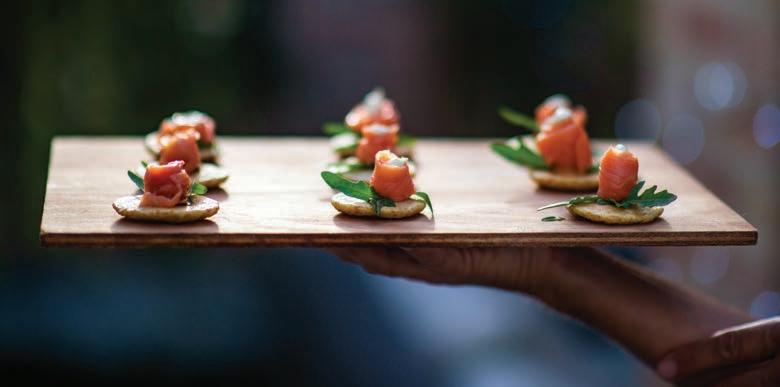
There are variables the garde manger cannot control. When adjustments need to be applied due to the environment, guests, resources, accompanying wines, team or time, the garde manger finds solutions. Starting with the highest quality ingredients available, the garde manger determines the skill and technique that will go into preparations. Based on what’s possible, it’s also the garde manger who makes adjustments in order to adhere to budget constraints while ensuring the “wow factor” remains.
That’s an ever-growing challenge in today’s economy, but it’s one the garde mangers of the world are prepared to tackle head-on.
As we look to the warmest months of the year, culinary preferences shift to lighter, brighter cuisine — “fruits of the ocean” and fare of the sun, if you will. For the garde manger, that often means perfectly chilled and precisely prepared sushi, ceviche, crudo and raw bar presentations with fresh, clean flavors.
Whether it’s citrus-swathed salmon ceviche Acapulco, studded with green olives and onions, or plump, briny oysters on the half shell, finished four ways, these crowd-pleasers carry their own set of practical and creative challenges.
“Ceviche, in particular, is a hard category because it’s obviously taken such a big hit with COVID,” says Mike Koysto, senior managing editor and “trendologist” with third-party research firm Datassential. “But seafood is second only to Mexican cuisine in the options that consumers say they are craving the most from restaurants.”
While ceviche is up only 3% on menus in the past four years, 67% of consumers who have had ceviche say they love or like it, according to Datassential. Just before the pandemic, more places were offering Peruvian-style ceviche, which features leche de tigre (tiger’s milk), a spicy citrus marinade that traditionally uses aji amarillo chiles and is made slightly creamy
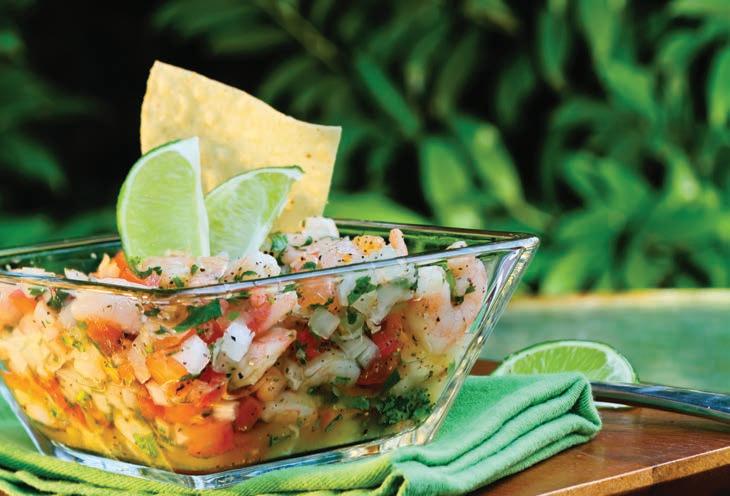
by the addition of pureed fish or milk, which balances the acidity. There were many trending Hawaiian iterations, as well as Japanese ceviche and crudo using popular ingredients like yuzu and furikake.
One type of ceviche that continues to remain popular, Koysto points out, is aguachile, a Mexican ceviche that hails from Sinaloa and literally translates to “chile water.” Datassential’s trend prediction tool, Haiku, estimates that aguachile’s appearance on menus will increase by more than 25% over the next four years. While recipes for aguachile vary, some common features of the dish are raw shrimp or fish, cucumber, red onion, lime juice and chiles — most commonly spicy chiltepíns, which are native to Sinaloa and may be foraged. Other peppers such as serranos or jalapeños are often swapped in, and they are traditionally crushed with water in a molcajete. Typical accompaniments for aguachile are avocado and tostadas. One of the big ways aguachile differs from other types of ceviche is that it’s served immediately after tossing the shrimp with lime juice,
Just in time for spring and summer, here are some trending ideas for a classic crudo // by Jennifer Olivera
instead of marinating for a bit. As aguachile is served cold, it tends to be most popular in the spring and summer, according to Datassential.
When it comes to ceviche, salt, acid and curing techniques are integral to preservation and preventing spoilage. Beyond practicality, though, ceviche has to taste great.
“Seafood salads should not contain mayonnaise or cream so they don’t spoil,” says Chef Fritz Sonnenschmidt, CMC, a retired 34-year instructor and dean of the Culinary Institute of America (CIA), as well as co-author of “The Professional Chef’s Art of Garde Manger,” a leading textbook on the subject. “The trick is seasoning chilled seafood just right. You have to make sure it is not bland.”
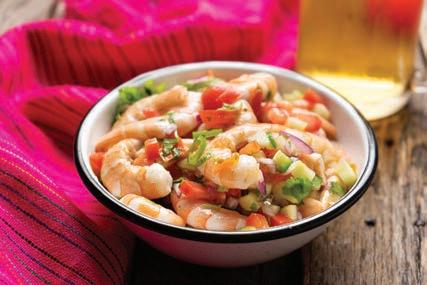

Recipe by Chef Fritz Sonnenschmidt, CMC, co-author of “The Professional Chef’s Art of Garde Manger”
Yield: 6 to 8 servings
Ingredients:
2 lbs. raw large shrimp, peeled, deveined thinly sliced
3/4 cup fresh lime juice
5 plum tomatoes, blanched, peeled, seeds removed, diced
1 red onion, finely diced
1/2 cup chopped cilantro
1 Tbsp. Worcestershire sauce
1 Tbsp. ketchup
1/2 tsp. or more hot sauce, to taste (optional)
2 thinly sliced scallions
Kosher salt and freshly ground black pepper, to taste
1 avocado, pitted, peeled, diced, for garnish
Extra-virgin olive oil, for garnish
Method:
Then there’s the matter of marination — too much and the seafood turns tough or winds up too salty. Chef Sonnenschmidt also recommends peppering in some sweet-sour presentations, which turn on taste buds and ensure flavors pop.
Meanwhile, Chef James Corwell, CMC, founder and chief innovation officer at Ocean Hugger Foods, likes to mix in a variety of plant-based, faux fish dishes that satisfy cravings and also are sustainable.
“I have also made tomato ‘sashimi’ that’s lightly seasoned with soy and rosemary,” he says. “But when you do use fish, remember that it’s a rarity and it’s expensive, a precious natural resource that you need to honor.”
1. Place shrimp and lime juice in a large bowl and marinate for 5 to 10 minutes. Add tomatoes, onion and cilantro. Mix well and refrigerate for 1 hour
2. Add Worcestershire sauce, tomato, ketchup, hot sauce (if using), scallions, salt and pepper and mix well.
3. Divide mixture evenly between 6 or 8 cocktail glasses and top with avocado and a drizzle of olive oil.
 By Robert Wemischner
By Robert Wemischner
Pastry chefs are breathing fresh air into a classic. The éclair— indisputably a workhorse of the pastry kitchen for years— is gaining a new lease on life, being positioned front and center by pastry chefs across the country, from Los Angeles to Chicago, Pittsburgh to Florida. Though legendary French pastry chefs Pierre Hermé, owner of eponymous patisseries throughout Paris and worldwide, and Christophe Adam, owner of L’éclair de Genie in Paris, are just two chefs accredited with moving the art of this
delicate pastry forward, American pastry chefs and bakers, too, are experimenting with tropical flavors, modern shapes and new textures.
The elegant éclair is a blank canvas onto which Los Angeles-based Pastry Chef Romuald Guiot , a practitioner and consultant in the pastry world, continues making his own mark. He tops piped-out éclairs with a crunchy, buttery sable dough (choux au craquelin) that includes a thin, crunchy wafer atop the pastry, often tinted with food coloring to give a clue as to what’s inside. “There are a seemingly infinite number of presentations and flavors possible,” says Chef Guiot, “but when I’m not featuring the crispy top covering, I’m old school when it comes to the icing. Creamy fondant brings the perfect level of sweetness to contrast with the filling.”
Pastry Chef Emilia Tomaszycki, pastry supervisor at the Ritz-Carlton Naples, Florida, and a participant on the Food Network’s “Holiday Baking Championship,” takes inspiration from other desserts, such as classic cannoli, when making her éclair rendition. Using the same flavors and textures of a cannoli, Chef Tomaszycki creates crunch by including shards of fried dough in the mascarpone-ricotta filling. She then packs in a few more of the classic Italian pastry’s signature ingredients, including pistachios, candied fruit and chocolate.
Pastry chef and consultant Jimmy Macmillan , owner of Pastry Virtuosity in Chicago, recalls loving éclairs as a child and continues to elaborate on them to this day by using bright tropical flavors. For instance, he likes to showcase pineapple in two forms in his favorite éclairs. A pineapple custard becomes the sweet-tart filling, and crystallized dried pineapple
Let your customers know you have their safety in mind.
New ACF COVID-19 Safety Training
Take the ACF COVID-19 Safety Training for Foodservice course and earn a certificate and verifiable digital badge that can be displayed on your website and social media channels.

Available in the ACF Online Learning Center. Visit acfchefs.org/OLC
Topics Covered:
• Key Features of COVID-19
• Minimizing Risk and Preventing Spread

• Best Practices for Foodservice
• Examples from Chefs in the Industry
appears as a garnish on the éclair’s bright yellow glaze. When Chef Macmillan makes Paris-Brest, a choux pastry that’s shaped like a bicycle wheel and named after the two French cities that used to host a cycling race, he uses milk instead of water as the liquid. “This makes the piped rings a bit softer when we cut them in half horizontally to make room for the filling before the final assembly,” he says. He uses the paste to make cookie-shaped ‘éclairs’ filled with a light hazelnut, Chantilly cream and crushed candied hazelnuts. “As in many pastry-based desserts, texture is everything,” he says.
Chef Tomaszycki also experiments with the texture of the classic pastry. “Whenever possible, I like to fill the baked éclair shells at the last possible moment to preserve their beautiful, delicate crispness,” she says. For catered events in the past, Chef Tomaszycki has created an éclair bar in the form of an à la minute action station that allows guests to pick and choose among different fillings and glazes. “I’m a fan of offering guests sauce-filled pipettes that allow for an interactive experience where the client can use as much of the accompanying sauce as they wish.”
By also building up an inventory of baked éclairs, Chef Tomaszycki can whip the pastries out of the freezer, and in a matter of minutes in a hot oven, restore them to that just-out-of-the-oven freshness. Adding yet another texture to the mix, she will sometimes use a base filling layered with a custardy coffee crémeux studded with cacao nibs or a salty chocolate crumble topped with ribbons of whipped vanilla mascarpone cream. When plating, she says, “microgreens and edible flower petals add a lovely accent to the finished plate with its pool of coffee crème anglaise, along with dots of chocolate and even a scoop of vanilla ice cream.”
Chef William Racin, CEPC , executive pastry chef at the Duquesne Club in Pittsburgh, Pennsylvania, follows the classical method, baking éclairs in an oven that is initially set to 425°F to maximize the rise and then reduced to 375°F for thorough browning. He also often adds 5% cocoa powder to the paste for a flavor variation and uses a four-sided mold to create a cube shape. “That always seems to yield a ‘How did they do it?’ from our guests every time,” he says.
Choosing flour with lower protein content also creates a softer paste with more oven spring for a more ‘rustic’ version of the classic. For large catered events featuring mini éclairs, Chef Racin
says, “I favor piping out the choux paste in long sheet-pan-length tubes, and then I freeze those and when ready to bake, cut them to the desired length.”Agreeing with other innovative pastry chefs, he says: “I also like the longer-lasting crunch that a sablé — that sandy-textured, buttery dough — adds to the éclair.”
Fruit is an ongoing theme for Chef Racin’s éclairs. “I like to use freeze-dried fruits in powdered form for intense flavor,” says Chef Racin, who adds pectin to create a jelly-like filing for his éclairs. That creates a nice layer of acidity to balance out the richness of the other components. Fillings like crème légère, whipped custardy crémeux and Chantilly cream, where more air is incorporated, also help lighten the pastry. “I am always thinking of the end user whose palate might tire easily if confronted with an éclair that is strictly one-noted,” he says.
Nuts also add new flavors and textures to éclairs, taking the form of frangipane, brittles, creams, butters and marzipan that are incorporated into the filling. Subscribing to the philosophy that less is more, Chef Racin says he avoids using strongly flavored glazes to prevent masking the delicate flavors inside and to make the éclair-eating experience less messy.
With a widening variety of tools such as these in the éclairmaking toolbox, chefs are rewriting the rules, one choux at a time.
"I’M OLD SCHOOL WHEN IT COMES TO THE ICING. CREAMY FONDANT BRINGS THE PERFECT LEVEL OF SWEETNESS TO CONTRAST WITH THE FILLING."
- PASTRY CHEF EMILIA TOMASZYCKI
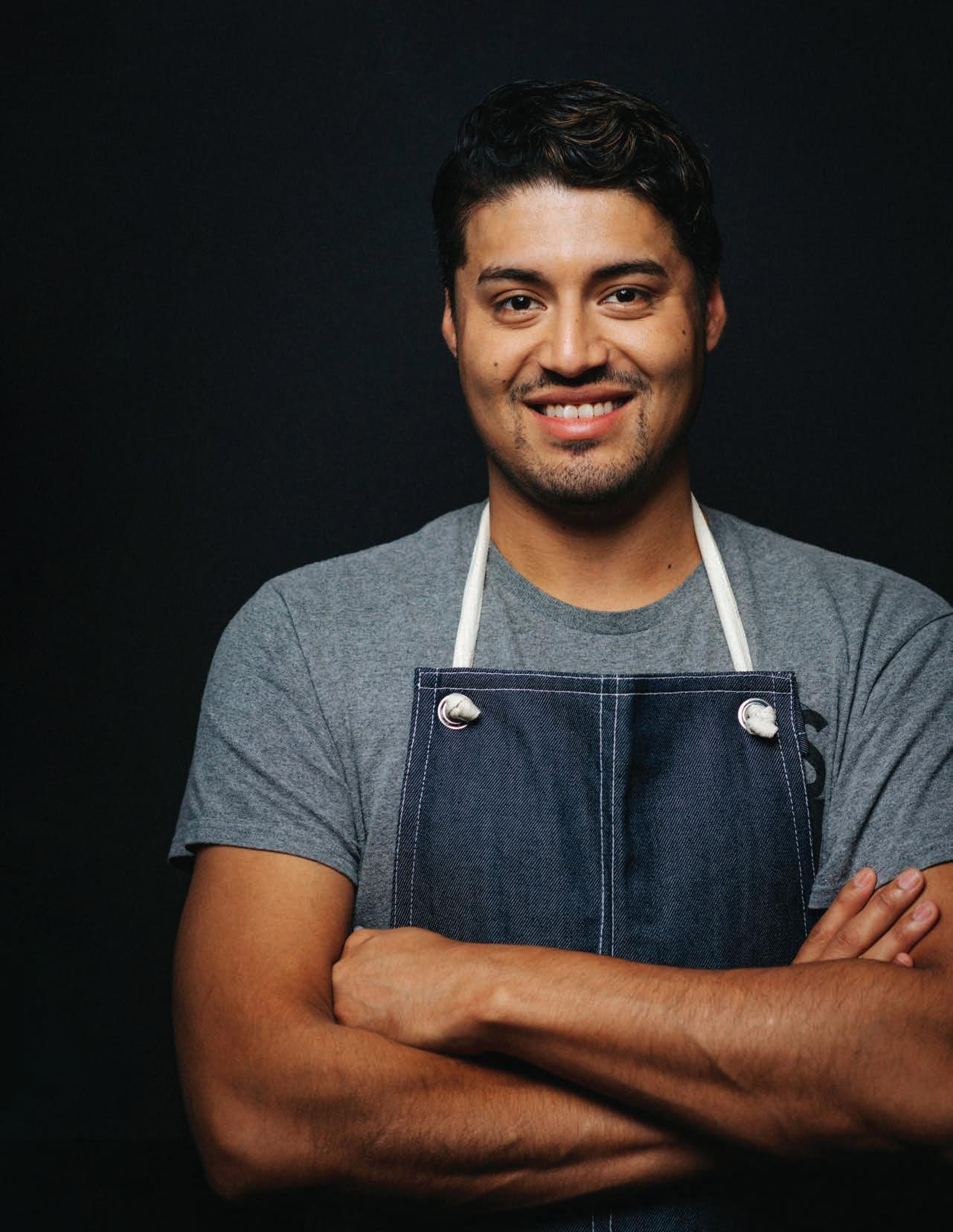
For many, springtime signals lamb. A classic rack of lamb that’s properly frenched, seasoned and pan-seared never fails to satisfy. In taking a traditional route, Chef Robert Velarde, CEC, executive chef at Chartwells School Dining Services (which serves Edina Public Schools in Minneapolis) coats the pan-seared meat with persillade, a mixture of herbs and garlic. He adds buttered breadcrumbs, or perhaps whole-grain mustard, before roasting the lamb in a 400°F oven until medium-rare. A lamb demi-glace, some nicely buttered and seasoned pommes Anna and roasted carrots or seasonal asparagus round out the dish.

For a modern take on a classic rack of lamb, Chef Velarde says his “new version is more of the way l like to cook now — I’m much more interested in world cuisine and the wonderful flavors to be discovered.” He swaps the bone-in rack for a boneless loin of lamb and seasons it with baharat, a slightly sweet and peppery spice blend that’s common in Middle Eastern cuisine. In this case, Velarde uses allspice, cinnamon, nutmeg, cloves and black pepper. Baharat could also feature paprika, coriander and/or cardamom seeds. Chef Velarde pan-sears the meat for a minute or two before brushing it with pomegranate molasses, topping it with crushed green pistachios and roasting it until medium-rare. Lamb demi-glace still makes a showing, this time paired with roasted summer squash and couscous studded with raisins and Iranian sour prunes. Fresh thyme and pomegranate seeds finish the dish. See the classical and modern recipes, as well as more photos, at wearechefs.com


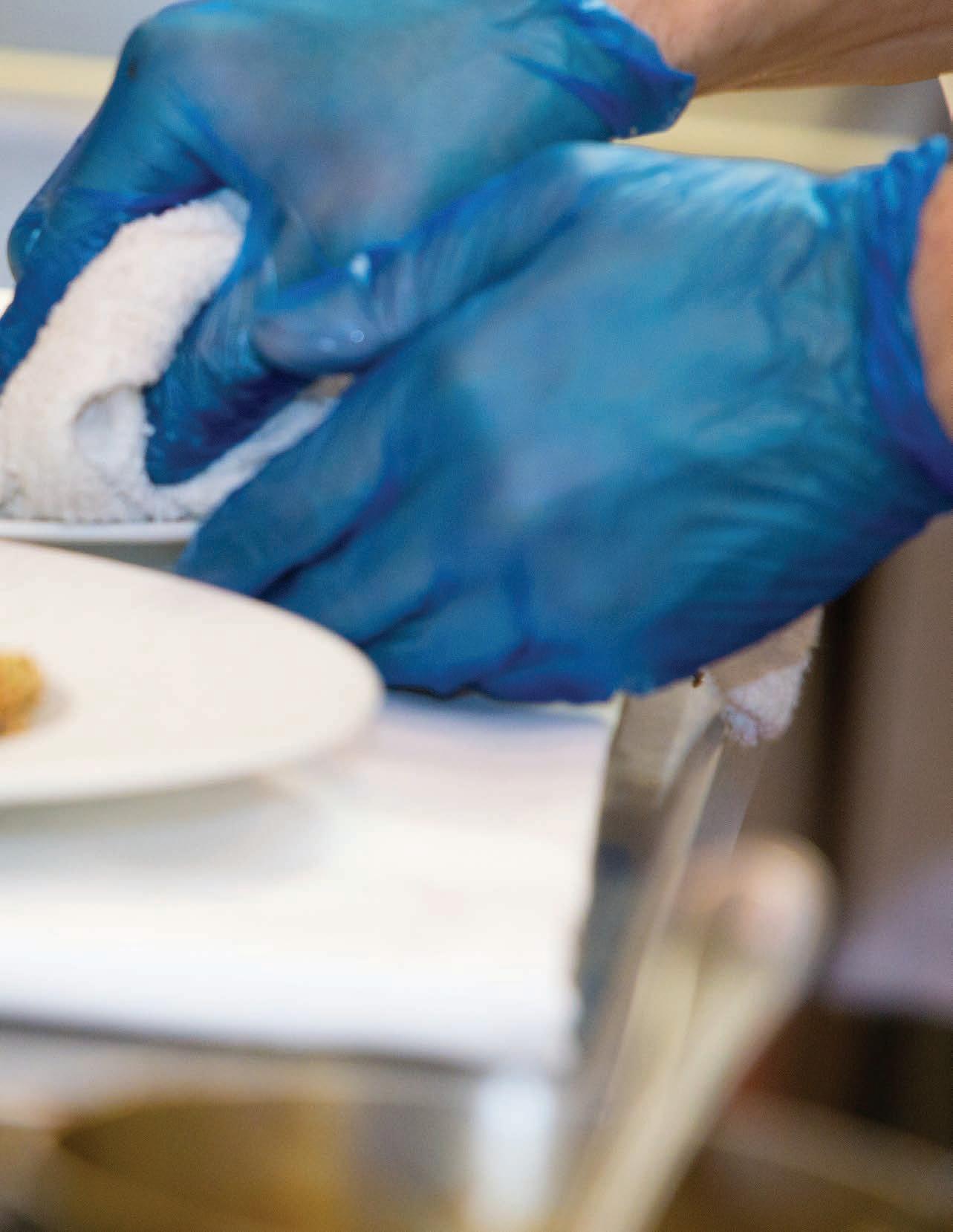
A look at the legacy and ongoing evolution of ACF’s hallmark program
// By Amelia LevinTo certify or not to certify?
Therein lies the golden question. Many chefs say certification is also the golden ticket when it comes to landing a better job (often with higher pay), getting ahead and staying current — especially during trying times.
“Earning your diploma isn’t the ‘endall, be-all’ in culinary arts,” says Chef John C. Schopp, CEC, CEPC, CCE, CCA, AAC, culinary arts instructor at Virginia Western Community College and chair of the ACF Certification Commission. “Graduating from one of the top culinary schools in the country doesn’t automatically make you the cream of the crop. Certification does.”
That’s because, Chef Schopp says, the ACF’s certification program is the only one that requires both practical and written exams to measure knowledge and skills. Those results are then verified by a third-party committee, and recertification is required every three-tofive years to show you’re on top of your game. “Even if I earned my CC years ago,” Chef Schopp says, “if I haven’t done anything to continue to earn education hours since, it loses its luster.”
Chef Joseph Leonardi, a Certified Master Chef (above, right), agrees.
“Certification validates your experience and demonstrates to employers that you have the right skills to bring to the table,” he says. “Especially during these times, when we just went through a major crisis in the industry, certification is more important than ever because there is going to be more competition for some of the key kitchen positions in the future.”
Employers can search the ACF’s database to verify that applicants who claim to have a valid, current ACF certification are indeed certified, offering yet another level of validation.
Still, Chef Leonardi, who is the director of culinary operations for The Country Club in Chestnut Hill,

Massachusetts, notes, it goes beyond just proving to employers that you know your stuff. “Certification is really for people who want to grow within the industry, not just in a company. It doesn’t even matter what level of certification you’re going for — it needs to be viewed as a stepping stone in your career.” More than just a resume or references, chefs Leonardi and Schopp say, certification is a demonstration of excellence and ethics in the field that provides a clear path for continued growth.
Certification has long been an integral part of the ACF. For nearly 50 years, the ACF has been the premier certifying body for cooks and chefs in America. In 1972, Chef Ferdinand Metz, CMC, AAC, and Chef Jack Braun, CEC, AAC, developed the first ACF certification program, actively supported by L. Edwin “Ed” Brown, AAC and Chef Wolfgang von Dressler, AAC .
In 1977, after years of work by ACF chefs to educate the U.S. Department of Labor about the rigid certification program they had developed, the federal agency reclassified the role of chef from “domestic servant” to that of “chef” in
the agency’s professional, technical and managerial category. Finally, American chefs would be accepted as skilled, trained professionals alongside other trade professions that had already earned such recognition.
Today, the ACF certification program offers 15 certification levels spanning savory, pastry, student, educator and administration categories.
“Certification has proven the single most important reason to join the American Culinary Federation,” Chef Metz, who served as president of the ACF from 1979 to 1983, has said. It “indicates both skill and commitment to the culinary profession.”
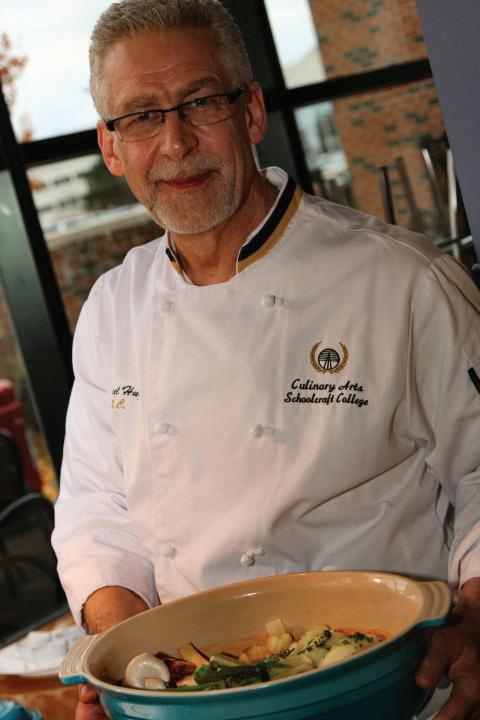
Guided by the ACF Certification Commission, certifications in the culinary/savory category begin with Certified Fundamentals Cook® (CFC®) at the most basic level and go on to include Certified Culinarian® (CC®), Certified Sous Chef® (CSC®), Certified Chef de Cuisine® (CCC®), Certified Executive Chef® (CEC®) and, finally, Certified Master Chef® (CMC®) at the highest level.
Pastry professionals may earn the title of Certified Fundamentals Pastry Cook® (CFPC®), Certified Pastry Culinarian® (CPC®), Certified Working Pastry Chef® (CWPC®), Certified Executive Pastry Chef® (CEPC®) and Certified Master Pastry Chef®(CMPC®).
Personal and private chefs can earn their Personal Certified Chef ™ (PCC™) and Personal Certified Executive Chef™
(PCEC™) designations to stand out in the niche field. This is one area of the culinary industry that Chef Daniel Hugelier, CMC, culinary specialist at David Meyers Associates, Ltd., a private club culinary placement firm, says is exploding as of late, partially due to the pandemic and restaurant closures. “I’ve been doing a lot more placements for private chefs with families and even as live-in residencies with big families that have huge properties,” he says. “These jobs are amazing because they can afford chefs the right equipment and the highest quality of food to work with. And they will definitely pay higher wages if you have certifications because they know you can work clean and consistently.”
Culinary educators can test for the Certified Culinary Educator (CCE®).
In addition to passing written and practical exams, candidates must meet criteria specific to each level of certification. Most certifications require a degree from an ACFEF-accredited secondary or post-secondary program, such as a culinary school or other
“CERTIFICATION IS VERY VALUABLE TO HAVE. IT DEMONSTRATES A LEVEL OF EXCELLENCE IN TERMS OF INDUSTRY STANDARDS. WE HAVE A NEW DIVISION FOR PRIVATE CHEFS THAT’S GROWING, AND EMPLOYERS ARE SPECIFICALLY LOOKING FOR THOSE WHO ARE CERTIFIED.”
– Chef Daniel Hugelier, CMC, David Meyers Associates, Ltd.
approved educational outlet. Also typically required are work experience and a certain level of continuing education hours with specific requirements for nutrition, food safety and sanitation. For those seeking leadership positions, the Certified Culinary Administrator® (CCA®) certification, which is open to all segments, demonstrates to potential employers extensive knowledge of business and management, including supervision, human resources and advanced sanitation.
Recertifying every three to five years (or upgrading or adding a new certification) is just another way to prove to employers and other decisionmakers in the industry that you’re on top of your game. “I could have graduated years ago with a bachelor’s or associate degree and become a CC [Certified Culinarian], but if I haven’t done anything since then, the certification is lost,” Chef Schopp says.
Chef Melinda Burrows, CEC, CCA , executive chef at Hickory Hills Country Club in Springfield, Missouri, is also a proponent of certification and recertification. She says it signals to employers and peers that you’ve earned the appropriate number of continuing education hours and are up to date on current trends, new safety and sanitation procedures, HACCP laws and other important guidelines and markers in the industry. That’s important not just for mid-career chefs looking to advance, but also for seasoned chefs in leadership roles, like Burrows.
“If you don’t stay current with trends and changes in the industry, how are you going to teach that to the individuals who you manage or are mentoring?” says Chef Burrows, who enjoys constantly
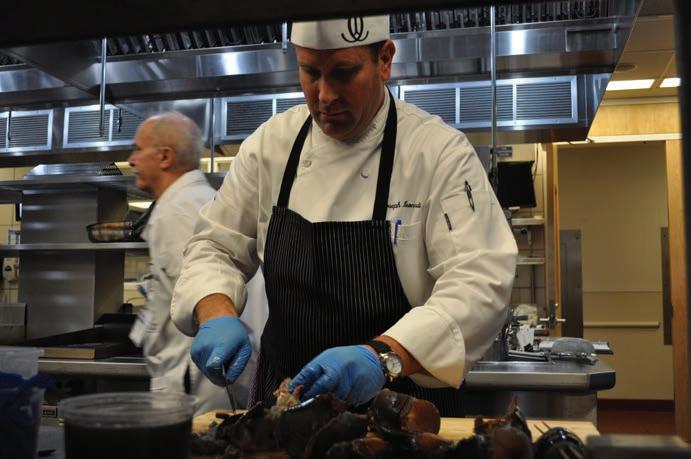
learning. “I loved taking all of the complimentary classes this past year through the ACF Online Learning Center and listening in on all of the webinars. And on the plus side, I earned a bunch of CEHs for doing so.”
In addition to the enhanced classes and webinars, also new this year are digital badges (not just the ones you sew onto your whites), which are available for members to post on their websites and resumes. Organizations with five or more chefs pursuing certification can work with the ACF through its new
“EARNING YOUR CERTIFICATION DEFINITELY GIVES YOU A LEG UP IN THE COMPETITION. IT SEPARATES YOU BECAUSE IT SHOWS YOU HAVE VALIDATED YOUR CRAFTSMANSHIP AND HAVE GONE THROUGH A TRAINING AND TESTING PROGRAM THAT HAS BEEN VALIDATED.”
– Chef Joseph Leonardi, CMC, AAC, director of culinary operations, The Country Club, Chestnut Hill, MassachusettsChef Joseph Leonardi, CMC, AAC, prepares a dish for the practical portion of the Certified Master Chef exam.
Certification Concierge Service, a no-fee service to meet the company’s goals and vision.
Chef Schopp and others with the certification commission have been working hard to evolve certification exams as they relate to global cuisines. Prior to the pandemic, Chef Schopp regularly traveled to Jamaica to train evaluators who could, in turn, proctor exams and certify local culinarians without the need to constantly fly in American chef evaluators.
Through this work, however, he noticed a few key issues. Some of the exam content tested those outside of Europe on the use of uniquely European ingredients like truffles and oysters, which are not readily available in the Caribbean.
“Cooks there literally know how to scale trees to collect coconuts, but they may not know how to shuck an oyster,” Chef Schopp says.
As a result, Chef Schopp and his team worked with subject matter experts up and down the Caribbean to create an exam that is 25% specific to the Caribbean. Other countries have shown interest in similar ventures.
“What we want as a commission is to be forward-thinking enough that we’re not pushing people away from the table because they don’t cook with certain ingredients,” he says. “We are examining our content to focus on knife cuts, cooking methodologies and techniques, leadership skills, safety and sanitation knowledge and the ability to understand cost control, while leaving room for more experimentation with regional, indigenous and heritage ingredients.”
Once considered the “Ironman” of certification —with a grueling eight days of on-your-feet testing — the Certified Master Chef (CMC) demonstrates the highest level of culinary excellence. Only a select group of chefs have passed over the decades.
The low pass rate — once considered a mark of prowess — created some concern for the American Master Chefs’ Order (AMCO), a 501(c) (6) nonprofit group of CMCs and CMPCs who came together in 2014 to establish a foundation to support those
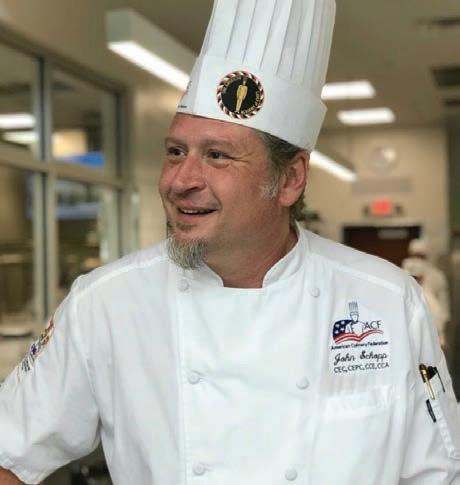
“I USE CERTIFICATION AS A HIRING TOOL AND FOR PROMOTIONAL DECISIONS, AND I’LL GLADLY PAY FOR IT BECAUSE NOW THAT PERSON IS WORTH MORE TO ME AS AN EMPLOYER. I WANT CULINARIANS WHO ARE IN CONSTANT GROWTH MODE AND CONTINUOUSLY LEARNING, NOT JUST WARM BODIES OFF THE STREET.”
– Chef John C. Schopp, CEC, CEPC, CCE, CCA, AAC, commission chair, ACF Certification Commission
taking the test and to encourage the growth of CMCs and CMPCs around the country.
“We started round-tabling this issue of the low pass rate and have been working to figure out how we want to shape the future of the test,” says Chef Jason Hall, CMC, (above) vice president of research and culinary development for Southbend and AMCO’s chairman of the board. After at last two years of deliberation and discussion, the exam now features two parts, each with four days of testing and exams. Other testing, including the sommelier and business management exam portions, will still be required ahead of time, as in the past.
The two-part test allows CMC applicants to take a break between exam portions — a move that supports chefs who can’t front the time, travel requirements or exam costs all at once. “The good news is: If you pass the first part, you own it and can move on to the next as fast or slow as you need to. You can even wait a year or more,” Chef Hall says. Like Chef Leonardi, Chef Hall says earning his CMC certification was a personal goal more than anything.
However, the expanded employment, travel and networking opportunities that accompanied his 2013 certification allowed the former country club executive chef to move to another side of the industry for a change of pace.

The modified exam was slated for a February 2020 rollout, but the pandemic put those plans on hold. Now, AMCO plans to roll out the modified exam in October at Schoolcraft College
Chef Melinda Burrows, CEC, CCA, executive chef, Hickory Hills Country Club, Springfield, Missouri
“AS AN EMPLOYER, I AM LOOKING FOR OTHERS WHO ARE CERTIFIED. IT SHOWS A DEDICATION AND COMMITMENT TO THE CRAFT AND TO THE PROFESSION. IT MEANS SO MUCH MORE THAN AN ARMFUL OF TATTOOS OR JUST UNDERSTANDING BASIC MISE EN PLACE. CERTIFICATION DEMONSTRATES DISCIPLINE, SOLID DECISIONMAKING AND FOLLOW-THROUGH.”
–
in Livonia, Michigan, with a goal to offer the second portion of the exam not long after. If the new exam is a success, Chef Hall says, it ideally will be offered twice a year.
Certification commission chair: John Schopp, CEC, CEPC, CCE, CCA, AAC
In addition to the exam structure, some of the subject material has changed. The group used both internal and third-party subject matter experts to review the entire body of content — ultimately deciding to drop the platter requirement to be more current with today’s la carte and plated trends. Another major change is that applicants now have access to the entire list of recipes that will be included in the test so that they are able to prepare. “In years past, you had no idea what you were going to get so it was just a shot in the dark,” says Chef Hall, who adds that recipes now also include a wider range of dishes and techniques from global cuisines. The group also removed some of the barriers associated with freestyle work with mystery baskets — reducing the number of ingredients in the baskets themselves while allowing more freedom to use outside supporting ingredients. The move gives candidates an opportunity to showcase their personal styles.
Immediate past chair: Scott Parks, CC
Chair-elect: Jonathan P. Moosmiller, CMC
Public member: Ramona Elmer
Chair: Michele Brown, CEPC
Commission member: Leah Schuler, PCEC
Commission member: David Voelz, CEC, CWPC, CCA
Commission member: Samuel Glass, CEC, CCE, AAC
Commission member: L. Fernando Mojica, CEC
Commission member, military: Justin Reed
Commission member, military: Marc Paul Susa
For detailed information on the steps required to certify at any level, as well as contact information, required documents and practical exam site locations, visit acfchefs.org .
As the premier certifying body for cooks and chefs in America, The American Culinary Federation remains committed to providing you with the tools to achieve your professional goals. We are pleased to announce the launch of a new way to communicate the ACF credentials you have earned in the ever-expanding online marketplace — at no cost to you!

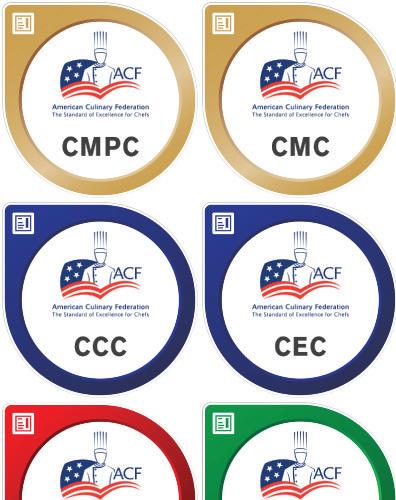
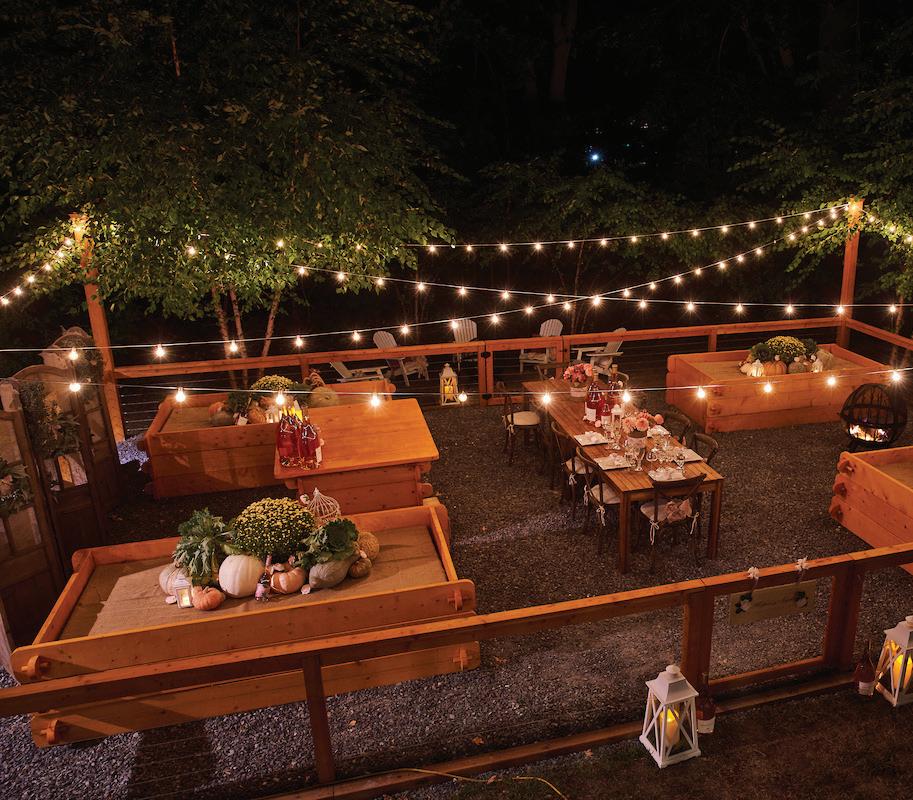

When the COVID-19 pandemic changed the world last March, the two ARC restaurants in Costa Mesa and Newport Beach, California, offered only very limited possibilities for dining outside. But with dining rooms closed, owner Marín von Blöm decided to change that.
In her Newport Beach location, ARC Butcher & Baker, von Blöm leveled some parking spots and created a brand new dining area with around 40 seats. At ARC Food & Libations in Costa Mesa, she repurposed a plaza space between two buildings and added seating for 30. Von Blöm added some umbrellas, but they can only withstand light rain; overhangs from the two buildings provide some protection from precipitation. “Weather is affecting business a lot more now,” she says.
But the most important thing for von Blöm was offering more than just food in an outdoor area: She wanted to offer the same atmosphere a guest would experience when dining inside.
“People are paying not just for food but also for ambiance and service,” she says. “So if you want to charge the same price as you did prior to the pandemic, you have to give guests experience, too. With outdoor dining, it’s really important to offer as much as we can of our original product and to uphold our brand.”
Von Blöm, who’s done a lot of the interior work on both restaurants herself, eschewed the idea of a large white tent from the get-go. “I’m very much about aesthetics, and I wanted people to be excited to dine outside.”
As a result, she built (literally, herself) an awning for ARC Butcher & Baker out of polycarbonate steel sheets, which are tinted with an SPF of 50 so they filter out a lot of light, though plenty still comes through.
She also made some wooden planters for each location that look like window boxes. Von Blöm whitewashed them and planted them with lilacs and purple potato vines. “I wanted it to be very attractive,” she says.
At ARC Butcher & Baker, von Blöm installed globe lights on table-height planters all around the patio. She added ground-level heaters to both locations, which she says work much better than overhead heaters because ground-level heaters warm the space from guests’ feet up. However, von Blöm notes, the propane cost has been unexpected and at one point, she was spending $600 per week for propane at ARC Butcher & Baker. That figure dropped once she covered the patio space because she was able to turn down the heaters.
Another plus of doing it her own way, von Blöm says, is that she saved a lot of money. Renting a large tent would have cost around $4,500 per month. To renovate both patios, she spent $37,000 – and they’re now permanent fixtures, providing the cities where the restaurants are located approve the patios for postpandemic use.
Last December, Chef Rob Wilson completed $50,000 worth of improvements to his restaurant, Glasspar, in Dana Point, California.
He designed a new canopy to cover his 2,500-square-foot patio. “It’s not 100% weatherproof but enough to keep in the heat and have an enjoyable dining experience,” he says. The cost of this was the bulk of his expenditure. The canopy’s steel frame is sloped so any rainwater runs over; the previous roof was flat. The top and sides of the structure are covered with Sunbrella, a waterproof canvas, with clear fabric sides that can be rolled up in different segments. “It keeps the heat in and the weather out,” Chef Wilson says. Three emergency exits are left open for ventilation.
He also had his heaters rebuilt and installed thermostats so the heaters come on if the temperature drops below 75 degrees, which has helped save money. He also has three other fire elements with natural gas that give off heat, too. Chef Wilson added festoon lighting and has three giant custom-made light fixtures.
And it’s been a good investment, Chef Wilson points out. His patio fills up and even extends into a nearby courtyard his landlord has allowed Chef Wilson to use for an additional 13 tables.
At the Inn at Hastings Park in Lexington, Massachusetts, Chef Trisha Pérez Kennealy and her team created the Whispering Angel Culinary Garden and its Igloo Wonderland, featuring six igloos for lunch and dinner that can seat up to six guests. Each igloo is decorated with lights and includes blankets (washed after every use), faux-fireplace heaters and speakers.
Because the restaurant was forced to operate at 25% capacity this past year during the pandemic, only two igloos were operated at a time because they were included in the state’s operating capacity level.
During the week, customers can dine a la carte in the igloos, but on weekends, there is a four-course Champagne brunch offered during the day and a set dinner at night. The minimum spend is $200 during the day and $400 at night. “Some customers just want a romantic date and book out an igloo,” Chef Kennealy says.
Each igloo cost around $1,100, but Chef Kennealy has already seen a return on her investment. She’ll store them at the end of the season and plans to use them after the pandemic for fun events like gingerbread house decorating or Halloween haunted houses.
Chef Eric LeVine also opted for igloos at 317 Main Street in Farmingdale, New York, as well as hot houses — three of the former, and six of the latter. Each is rigged with lights and Bluetooth speakers so that guests can play their own music. Each structure seats six guests but can be booked for as few as two, and there’s no rental cost, he says.
“It’s just another way to accommodate our customers,” says Chef LeVine, who expects the igloos and hot houses to remain popular post-pandemic. Both have been popular in the winter — but only up to outdoor temperatures of about 20 degrees, he says. At very low temperatures, he notes, it’s also a challenge keeping the food warm.
As the country moves into warmer weather, even with fears of COVID dissipating in the future, restaurant chefs and operators believe their outdoor spaces will only be a boon for future business.


"WITH OUTDOOR DINING, IT’S REALLY IMPORTANT TO OFFER AS MUCH AS WE CAN OF OUR ORIGINAL PRODUCT TO UPHOLD OUR BRAND."
MARÍN VON BLÖM OWNER, ARC RESTAURANTSAbove: Various outdoor dining options at ARC Restaurants in California.
Kang set his sights on the top, at one of Chicago’s top fine-dining restaurants. At the end of what essentially was a stage, “I must have done something right because they hired me.”
Chef Kang remained there for two years, working his way up the line. He then went on to work at other prestigious Chicago restaurants where he served in executive sous and executive chef roles, until he saw an opportunity at his alma mater, then Le Cordon Bleu College of Culinary Arts in Chicago.
Chef Wook Kang, CEC, never imagined he would become a culinary educator — let alone at a top-accredited international culinary school program, overseeing its growth across the globe. But that’s precisely where the 2018 ACF Chef Educator of the Year (Central Region) ended up, and it’s where he intends to stay.
Born in South Korea, Chef Kang moved with his parents to Chicago as a child and grew up primarily in the suburbs. At an early age, Chef Kang had an interest in food. He enjoyed watching his parents cook many dishes of his heritage, while also exploring the diverse foods and cuisines represented throughout Chicago’s neighborhoods.
“I was a good student but honestly didn’t know what I wanted to do my senior year of high school. I actually thought about being a Spanish teacher because I enjoyed my Spanish classes so much,” he says with his signature chuckle. “Food and cooking has always been near and dear to me, so when I did some soulsearching and decided to go to culinary school, I can honestly say it was the best decision I have ever made in my life. It has opened so many doors, and though it sounds corny, I knew this is what people meant when they always said you’ll know when you’ve made the right career choice.”
Chef Kang enrolled in the associates program at the former Cooking and Hospitality Institute of Chicago (CHIC), graduating two years later. In his search for restaurant jobs, Chef
After starting out as an instructor, Chef Kang went on to serve as program director. From 2012 to 2014, he was an integral part of Certified Master Chef (CMC) trainings across the U.S. That’s what got him evolved in the American Culinary Federation and ultimately propelled him to earn his Certified Executive Chef certification.

“Le Cordon Bleu had hired Chef Ed Leonard , a CMC , as its corporate executive chef, and he would come to Chicago a lot and we developed a good relationship,”
Chef Kang says. “Chef Leonard approached me about this opportunity to travel the country and help other schools and students understand what CMC training is like and what it takes to be a CMC. I ended up meeting so many people and learning a lot about the process of certification and what it can do for your career.” He also didn’t mind eating amazing food everywhere he went.
In late 2014, Chef Kang landed a job as chef-instructor at Kendall College at National Louis University. After teaching classes for four years, he took over many of the responsibilities of the retiring associate dean at the time. Now, as program chair, Chef Kang helps oversee curriculum planning and acts as a liaison with students. Prior to COVID-19, Chef Kang spent much time traveling the country and beyond to visit affiliate campuses in Mexico, Chile, Ecuador and Panama.
Today, Chef Kang can be found on the Chicago campus, continuing to plan curricula. He teaches an introductory class here and there, as well as an advanced
class for associates degree students in the fine-dining restaurant on campus, The Dining Room at Kendall College, which has earned a listing in the Chicago MICHELIN guide.
When asked about his teaching style, Chef Kang says he can geek out and likes to teach the “why” behind culinary fundamentals, breaking down lessons to the “lowest common denominator so everyone understands completely.”
“For example,” he says, “take a roast chicken. A lot of people wouldn’t bother trussing it. But that’s what helps it cook evenly and not dry out. And we can’t always just take the internal temperature. We have to look at what the chicken looks like when it’s perfectly cooked — looking at the color of the juices, the looseness of joints. I like students to try to understand the bigger picture of techniques, develop their palates and understand flavor profiles, rather than just focus on recipes.”
It makes sense that Chef Kang likes the nitty-gritty details and science of cooking. After all, he coached the national championship-winning ACF Baron H. Galand Culinary Knowledge Bowl team in 2017 and earned the title of ACF Chef Educator of the Year (Central Region) in 2018.
But Chef Kang says there’s more to culinary education than just teaching skills. With so many of his young students about to enter an incredibly demanding and competitive industry, “I always like to tell students how critical it is to be humble,” he says. “Some students don’t know what it’s like to be humble until they get humbled when they fail or someone does something better than them. But that’s OK, and that’s what makes us all better.”
Chef Kang focuses on preparing students for the times they might fail —even in their current class — by teaching them not only to recover and learn from their mistakes but also to build confidence through self-reflection. He credits this attitude to his parents and the chefs for whom he has worked. One might argue it is Chef Kang’s enduring work ethic that has allowed him to move up through the culinary ranks as swiftly as he has. “Cooking takes some natural talent, but at the same time, the ones who succeed are truly disciplined and dedicated to their craft and push themselves without letting a huge ego get in the way.”
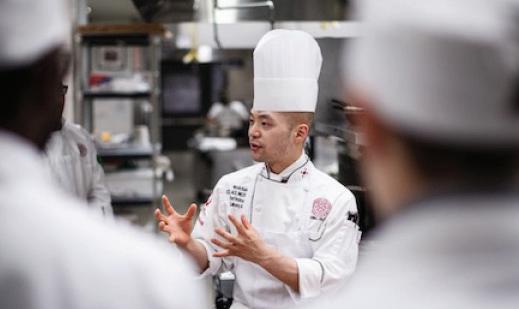
Outside of the classroom, Chef Kang remains committed to continuous learning, whether that means dining out or eating anything and everything while traveling (and at home). “I’m one of those weirdos who gets to the airport four hours early
just to eat different food,” he says with a chuckle. Chef Kang also enjoys experimenting in the kitchen, playing with the foods and ingredients of his native Korean cuisine (gochujang, banchan, kimchi) and pairing them with foods from other cultures in the U.S. and around the globe. He also remains committed to keeping current with his certifications; in addition to CEC, Chef Kang holds certifications as a Master Certified Food Executive (MCFE) and Certified Food and Beverage Executive (CFBE). Prior to COVID-19, Chef Kang was very active with ACF, routinely delivering presentations at conferences. “I enjoy learning new things every day and seeing what opportunities there are for me within this industry to give back to my students,” he says.
These days, with the culinary industry at a potential tipping point for major change and growth, Chef Kang enjoys helping his students see what opportunities exist beyond becoming a restaurant chef. “I truly loved my experience at culinary school, and it helped me have a better understanding of what’s not just available for me as a graduate, but also what’s available for students coming out of school — whether it’s becoming a research and development chef or food stylist or chef at a major healthcare facility,” he says.
In whatever limited spare time he has, Chef Kang works on a podcast he developed with a culinary peer and wine expert John Laloganes, who is a fellow Kendall College instructor and awardwinning sommelier. In “Feeding the Soul 365” (@feeding.the. soul365 on Instagram), the duo covers a wide range of topics in the food and culinary world — just another extension of culinary education for Chef Kang.
“I truly believe everyone has a special role in their lives,” he says. “I have been blessed as a culinary educator, and I hope to do this job as long as I live.”
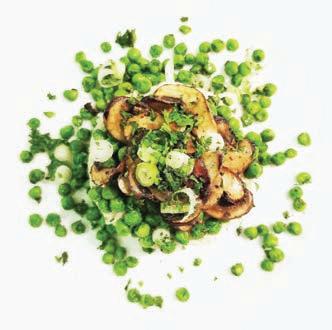

science and did my studies to really own a subject. My body was my lab. What I found was that by eating mostly plants, my recovery time was faster, I was stronger, and I was winning consecutive contests — all as a result of a change in diet that I thought could never make such a difference in my performance.
When I went to culinary school, I took what I learned during those bodybuilding days a step further and began to shape a career based on creating delicious, plant-based meals that even non-vegans can enjoy. That idea is based on lessons from my father, who is also a chef. My dad always told me that the most important thing is that the food has to be delicious. No one wants to eat something good for them if it doesn’t taste good — and rightfully so.
Not everyone knows that I was a competitive bodybuilder at one point in my life. It was then, more than 20 years ago, when I first became interested in exploring the vegan lifestyle to help shape my physique and improve my energy. I wanted to get an edge up in the sport, but I found that eating animal protein was no longer working for me and I needed to consider alternatives.
My body stopped wanting any form of animal flesh or animal product — literally. I would get nauseous at the thought of eating it, and coming from a sport where everything was based on muscle, I really was challenged. I was of the school of thought that you build muscle through animal protein. So, I dove quite deeply into nutritional
Contrary to popular thought, it’s actually not that difficult to make healthy food taste delicious. Here are some ways to do that.
Change the way you cook vegetables. Although adding more vegetables to dishes can make them healthier, it’s important to pay attention to how you are cooking them because they may not be as beneficial as you think if you’re doing it incorrectly. Many people think there’s nothing to cooking vegetables, but it’s easy to overcook and destroy their nutrients. I rarely boil a vegetable — not just because it’s easy to ruin the taste, but also because you can boil out all of the vitamins and minerals, which leach into the water. Rather, I will roast, steam, blanch or grill vegetables instead.
Leverage good fats by cutting back on oils. If you’re talking about eating healthier, maybe you want to replace pre-processed olive oil with olives — where you’re using whole olives with all their added nutrition. Or take an avocado, for example. When you use or eat the avocado in whole form, you also get the benefit of fiber and vitamins, along with healthy fat. In avocado oil, all those additional benefits are stripped from the fruit. It’s better to get fats from your whole foods because our bodies know what to do with them and will derive more nutrients from our food in that way.
Incorporate organic foods into dishes. One great way to make a menu healthier is by incorporating organic foods into dishes. Though many chefs may be reluctant to do this because of the cost, there is a strategic way to incorporate these ingredients into your menu to make dishes healthy without busting the budget. For one, not everything needs to be organic. Focus on the “Dirty Dozen” and “Clean Fifteen” lists. Avocados don’t need to be organic because the skins are thick, and that protects the flesh from exposure to chemicals. As a result, avocadoes tend to remain on the Clean Fifteen list all the time. Strawberries, however, don’t have thick skin protection. Because we ingest the whole fruit without peeling, there is more risk of exposure to pesticides and fungicides.
Brighten vegetables with acid. Ingredients that can make your vegetables pop are citrus fruits, such as lemons and limes, and apple cider vinegar. These ingredients help cut down on the amount of salt you’re cooking with and can really help brighten your dish without the need to add sugar or extra fat.
Add crunch. Crunch factor is always important as you transition to more plant-forward cooking, and texture matters. I love to
toast nuts, seeds and legumes and add them to my dishes. I make a walnut and lentil taco “meat” with traditional taco seasonings. To do this, toast the walnuts, and once cool, pulse them in a food processor until they are roughly chopped but not as fine as flour. Then, cook green lentils al dente, not too soft. Once cooled, pulse the lentils in the food processor until they resemble ground meat. Mix with the walnuts, and then add in spices and just enough oil to make the mixture glisten. Warm in a skillet and serve with tortillas or as a topping for a salad or bowl.
Although it may sound daunting, it doesn’t take much to make healthy dishes delicious. With planning and a few tweaks to the menu, any chef can create healthy choices that diners love, not just tolerate. For a plant-based haystack recipe by Chef Curtis, visit WeAreChefs.com
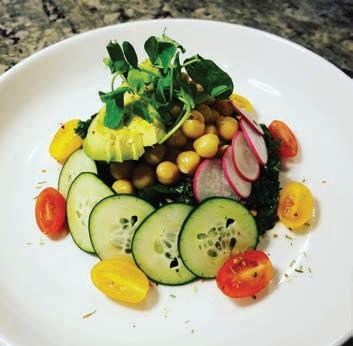

There’s an old saying that goes: ‘Meat is meat, and man must eat.’ These days, however, chefs would be wise to balance their meat, poultry and seafood offerings with plant-based fare that combines innovation with great taste, competitive pricing, social consciousness and health benefits.
“Thirty-five percent of respondents said they eat plantbased burgers at least occasionally,” Mark Brandau, an analyst with third-party research firm Datassential, says in reference to a survey conducted in January. “We asked consumers what motivates them to try more plant-based items, and while health reasons ranked highly, they said taste is paramount. They need to be convinced it can taste better, or as good as meat. They also mentioned if it were more affordable than meat, they’d be more willing to try it.” The most common type of plant-based foods consumed today are plant-based burgers.
For restaurateurs, the message is clear, he adds. “If you can thread that needle – offering a plant-based substitute that’s competitively priced and tastes good, it’s a really good proposition. What’s more, 29% of people say reducing their impact on the environment is important to them. So if you can find plant-based items with a low carbon footprint, definitely market that.”
At the University of California Los Angeles, Chef Joey Martin, senior executive chef of dining services, says promoting the planet’s health is an important part of the university’s ethos. He introduced more vegan choices in keeping with the university’s ambitious goal of a 10% reduction of animal proteins year-over-year, and steered toward using ingredients with a low carbon footprint.
“We created a ‘soy-frito’ where tofu, sautéed with onions, peppers, garlic and spices, serves as a meat substitute for taco salads, burrito bowls and any application that requires it,” Chef Martin says. “We also offer pink lentils seasoned with Latin spices, a vibrant looking dish that’s full of flavor.”
Promoted for their low carbon footprint, these vegan dishes have steadily gained traction on the menu and are distinguished by a green planet icon that translates to low

carbon footprint. Other dishes that have a high carbon footprint have a red planet, indicating that the ingredients have traveled further distances and required more resources to make it to the plate.
“We’re very transparent about the choices we’re making in our dining services,” Chef Martin says. “We don’t want to limit our diners’ options, but we do want them to understand the reasoning behind our choices.” To that end, each week the university gathers student focus groups where debates on the subject go back and forth.
“Telling the story of why we’re doing this and having guest buy-in is our biggest opportunity,” Chef Martin says. “We are training our students to be the next ambassadors, so when they leave the university they will promote this kind of food out there.”
At Honey Salt, a farm-to-table restaurant with locations in Las Vegas and Vancouver, Elizabeth Blau, founder and CEO, has a special vegan menu aside from her regular menu and features rotating vegan specials each week. There’s a slowroasted cauliflower steak with seasonal vegetables, arugula and chimichurri (above), and a butternut squash curry in which parsnips, carrots, basmati rice and chickpeas are served with a coconut-milk-based sauce. Both dishes menu for $19.
As the plant-based movement continues, more chefs are experimenting with new ingredients and flavor combinations
“If you’re vegan, you’re used to making accommodations on a menu,” she says. “We don’t want people who refrain from eating meat to feel like second-class citizens. We don’t believe in fake meats, nor do we believe you have to sacrifice flavor or excitement in a dish by losing animal protein.”

When her culinary team creates a new vegan or vegetarian dish, the focus is on maintaining overall balance while playing with flavors and textures using seitan, seeds, nuts or even mushrooms. While fried chicken sandwiches and the restaurant’s animal protein ‘backyard burger’ still outsell the vegan offerings 10-to-1, Honey Salt still celebrates and continually innovates with its vegan offerings.

At Pinewood Kitchen & Mercantile in Nunnelly, Tennessee, Chef-Owner Mee McCormick (above, right) goes one step further, focusing on gut-friendly, allergen-free menu items. “Gut health is about creating food that supports people in their wellness — menu items that are probiotic, loaded with lots of plants and are delicious; this is the face of the new hospitality,” she says. “The variety and diversity of ingredients is what influences our health.”
Chef McCormick continually reinvents her bean burgers, rotating beans like black-eyed peas, chickpeas and lentils, and adding parsley, onions and garlic. She also folds in grains — from quinoa one day to rice or millet the next. Sautéed onions, bell peppers, garlic and mushrooms add additional texture and flavor.
Every weekend, Chef McCormick sells out of her tomato soup, a rich soup made with almonds or cashews, nutritional yeast, tomatoes, basil, onion and garlic, and finished with
probiotic-rich miso paste. Her carrot weiners (above, left) — which contain a striking absence of processed, vegan meats - are among her top sellers. Peeled carrots with rounded ends are simmered in a marinade of tamari, liquid smoke, cumin, mustard and apple cider vinegar until the carrots are softened but still retain their shape. They sit in the cooler overnight and are grilled the next day and served with pickled squash and turmeric relish. “I want to inspire people to eat more plants,” she says.
Even the guests at Pinewood Kitchen, which is located more than an hour from the nearest city, continually ask for meatless options, Chef McCormick says. “The people who eat in my restaurant are southern, rural people, and they still want the vegan options. So, don’t think your customer doesn’t want it,” she says. “I’m here to tell you people want to eat and feel better. If you give them more plant-based options, you will win over your diners.”
Chef McCormick believes some chefs and restaurateurs are overlooking a major audience by not introducing or increasing their offerings of plant-based foods. “There’s always at least one person in a family who wants to [forgo meat], and the media is telling consumers to eat more plants,” she says. “This means we have to make substitutions and give customers what they want. That old idea that there should be no substitutions on a menu has to go away because diners want to go to a restaurant that supports them and is thinking of their health and wellness.”
While dining outside the home has been critically affected by the COVID-19 pandemic, perhaps no area of it has been more damaged than catering — a revenue pillar when it comes to country clubs in the form of banquets and events.
At the River Oaks Country Club in Houston, Texas, banquet business is down by around 77% — or $4.2 million, Executive Chef Charles Carroll CEC, AAC , says. He imagines weddings will continue to be smaller for another year or so but expects to see events picking up throughout the year. “Part of me wants to believe we’ll have a stronger fourth quarter, maybe 58% of banquet business from the norm,” he says.
To make up for the loss, Chef Carroll has organized different outdoor events, however, such as drive-in theaters with golf carts, kids’ nights, live concerts, Oktoberfest and wine tastings. “We’ve really had to think about how to do our events and how to do them outside,” he says. Most of these events have had about 50 or fewer attendees.
At Hickory Hills Country Club in Springfield, Missouri, banquets were down by 374% in 2020 compared to 2019, though wedding business remains strong, with events about 50% smaller than before, Executive Chef Melinda Burrows, CEC, CCA , says. Luckily, in February 2020, the club had just finished renovating a large patio, which proved very popular. “It really lengthened the dining season because people didn’t really want to eat inside,” she says.
Chef Burrows at press time already has six weddings on the calendar for 2021 and 25 golf events, so “we’re hopeful to be close to normal by mid-summer,” she says. “We continue to be at 50% capacity in all areas. Once the weather is nicer, we’ll definitely be full everywhere.”
Executive Chef Richard Crisanti, CEC, CCA, AAC , halted all banquets at Shadow Wood Country Club in Estero, Florida, last spring and instead, turned outdoor event spaces into areas for a la carte dining. He also uses all three kitchens to prepare food for the club, instead of having one kitchen dedicated to banquets. His total food sales would have been around $5 million in 2020, he says, with $2 million of that coming from banquets. However, on the plus side, dine-in and to-go business has increased by 15%.

Chef Crisanti has also implemented a strict reservation system, which helps guests more easily comply with safety rules. “Most people say their comfort level at the club is good and they feel safer here than at restaurants,” he says, “but that’s because we have a lot of rules and protocols.”.
When the pandemic started, Chef Crisanti saw a big boost in to-go business, and even now, 100 to 125 dinnertime meals are consumed off-premises. Before the pandemic, fewer than 20 meals would be ordered to-go nightly. He feels the trust members have about dining in extends to the to-go orders. “By now, most members have tried our to-go food, and they’re not going outside of the gates to order from anywhere else,” Chef Crisanti says, believing that the quality, speed and consistency of the meals keeps the guests returning. “We’ve created a new culture, a new business that guests were unaware of before.” Once business returns to normal, Chef Crisanti expects that
revenues will continue to increase 10% to 20% due to the steady growth of to-go orders.
Chef Crisanti says he’s lucky he did not have to change his menu to ensure it holds well for carryout because everyone in the community lives nearby. The challenge for him was more about having the right packaging and making sure guests picked up their food within 15 minutes of ordering. “We were thrown into this at the beginning, but we did our research to make sure we had the best bags and containers for to-go meals,” he says.
Like other club chefs, Chef Carroll has also been boosting his to-go business, which has increased by 67%. He’s adding lots of variety and offering cooking classes, virtual wine dinners, decorating classes for kids and meals for special events like Valentine’s Day.
Chef Burrows’ to-go business has jumped by a whopping 577% since March, and she expects to maintain “strong and steady” to-go sales moving forward. She is also running plenty of special to-go dinners: Valentine’s Day, a special fish Friday for Lent, winery events and themed meals such as Spanish dinners.
Hickory Hills did some takeout before COVID-19, “but it wasn’t a focus of our dining because it makes a herky-jerky service because you’re doing it right off the same line as the dine-in orders,” she says. While Chef Burrows thinks this revenue stream will taper off somewhat after the pandemic, she believes it will remain strong.

To keep things simple, Chef Carroll switched to offering just one menu for both lunch and dinner so that he could have two interchangeable groups of staff. To make up for the smaller selection of food — and the very limited-service buffet he offers — he’s doing more specials.


Chef Caroll has also added about 50 seats outside so that 50% of people eat outdoors, “and those reservations always sell out first,” he says. Firepits, Adirondack chairs, umbrellas, space heaters and tables make the space extra warm and inviting.
A big change that’s come out of the pandemic is that dining reservations are now required at River Oaks, which means both service and food have improved, says Chef Carroll, who hopes to retain this system post-pandemic. “We’ve known all along that reservations are better because it spreads out our diners, but it’s difficult to tell a member no [if they want to walk in].”
At Shadow Wood, outdoor dining will become a permanent fixture, thanks to newly installed covered roofs with vinyl sides and propane heaters. “Outdoor dining gives us the opportunity to have more people dine here when we’re having events,” Chef Crisanti says. “If guests want to continue to watch the sun set on the terrace, they can still do that. New habits are going to become the new normal.”
“ WE'VE CREATED A NEW CULTURE, A NEW BUSINESS THAT GUESTS WERE UNAWARE OF BEFORE.”
-CHEF RICHARD CRISANTI, CEC, CCA, AAC
As diners tend to order more appetizers, sides, desserts, and alcohol.






Beef is a proud sponsor of the American Culinary Federation. Follow the latest trends in beef, including innovative cuts, tools of the trade and inspiring menu ideas at www.beefitswhatsfordinner.com/foodservice




of operators say steak on the menu increases traffic2
















of operators say increased demand for the product is why they’ve increased ground beef volume2






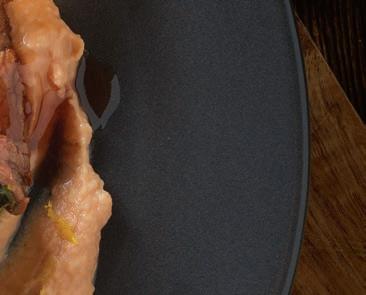




 NORTHEAST
PROMOTION INITIATIVE
NORTHEAST
PROMOTION INITIATIVE


According to the U.S. Department of Labor, positions in the food industry are projected to grow by 2029.
a. 5 %
b. 10%
c. 15%
d 40 %
What does the term Garde Manger mean?
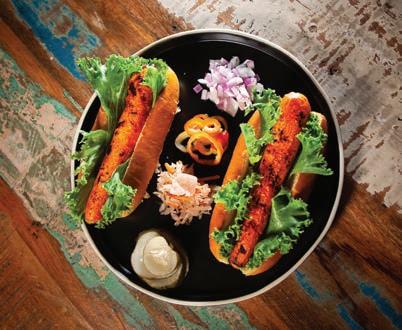

a. A n area in the kitchen used for preparing and storing cold foods
b. Chefs who preside over a specific area in the kitchen
c. The front-of-house kitchen manager
d. Both A and B
Hot dishes lose flavor when served cold.
a. Tr ue
b. Fa lse
What motivates consumers to try more plant-based items?
a. Pr ice
b. Ta ste
c. Environmental impact
d. A ll of the above
Which method of cooking vegetables is most likely to remove vitamins and minerals?
a. R oasting
b. Steaming
c. Bo iling
d. Gr illing
Which fruit is most at risk of exposure to pesticides and fungicides?
e. Strawberries
f. Pineapple
g. Avocados
h. Cantaloupe
According to Datassential, seafood is second only to in the options that consumers say they are craving the most from restaurants.
a. Gluten-free
b. Desserts
c. Mexican cuisine
d. Italian cuisine
Baharat is a slightly sweet and peppery spice blend that is common in cuisine.
a. Middle Eastern
b. Southeast Asian
c. European
d. North African
In 2020, how many Tampa Bay members went to the IKA Culinary Olympics?
a. 2
b. 4
c. 5
d 7
What is one main way aguachile differs from other types of ceviche?
a. It includes spicy peppers
b. It is served immediately instead of marinating
c. It is served cold
d. It is typically accompanied by avocados
What shape is a Paris-Brest?
a. A French city
b. A tube
c. A b icycle wheel
d. A tree
What is persillade?
a. A breadcrumb coating
b. A mi xture of herbs and garlic
c. A side d ish of carrots and herbs
d. A variety of mustard seed
See the rest of the questions, finish the quiz and earn 4 CEHs toward your certification on ACF’s new Online
Center at acfchefs.org/olc
Unbeatable:
Unique:
Versatile: Use as your primary or second fry for both on-and off-premise customers



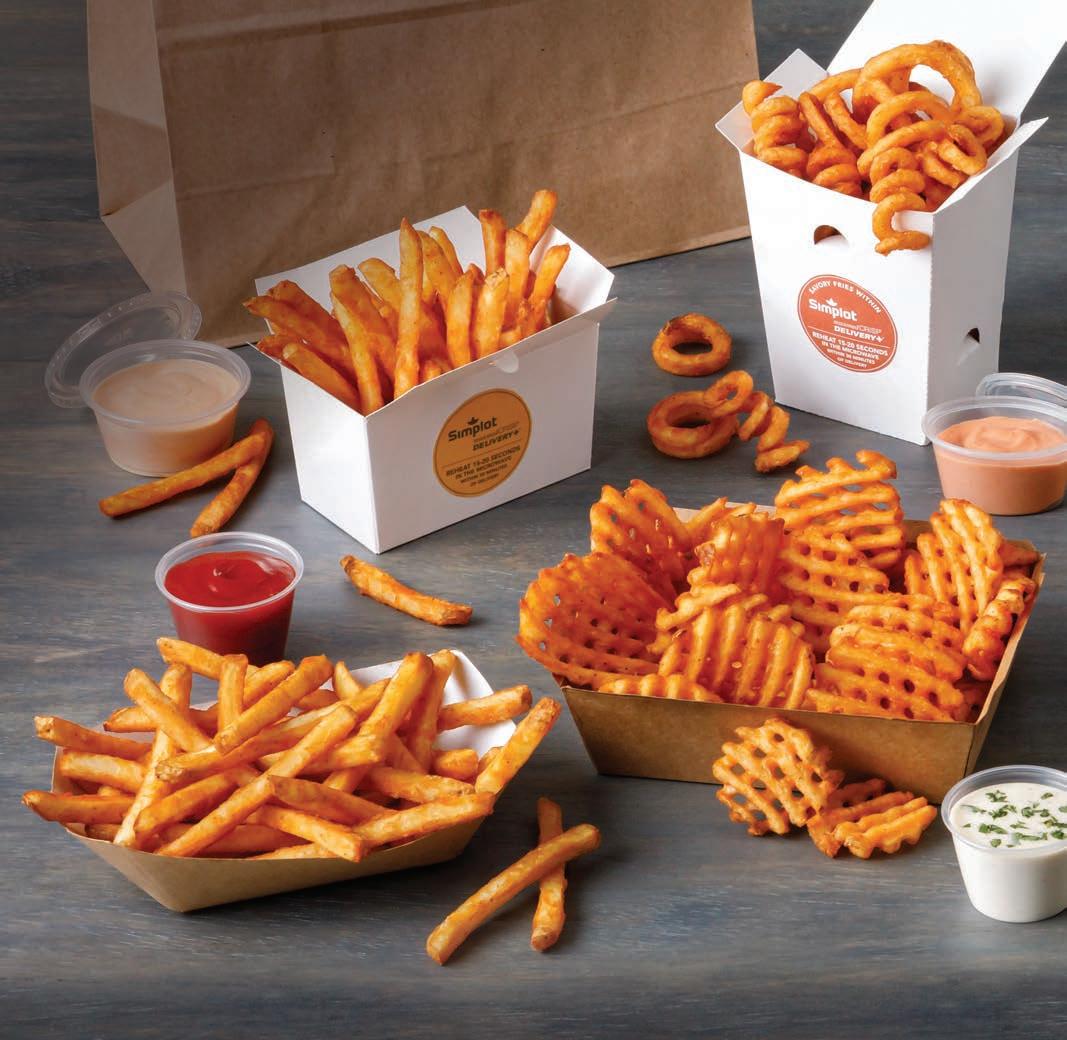
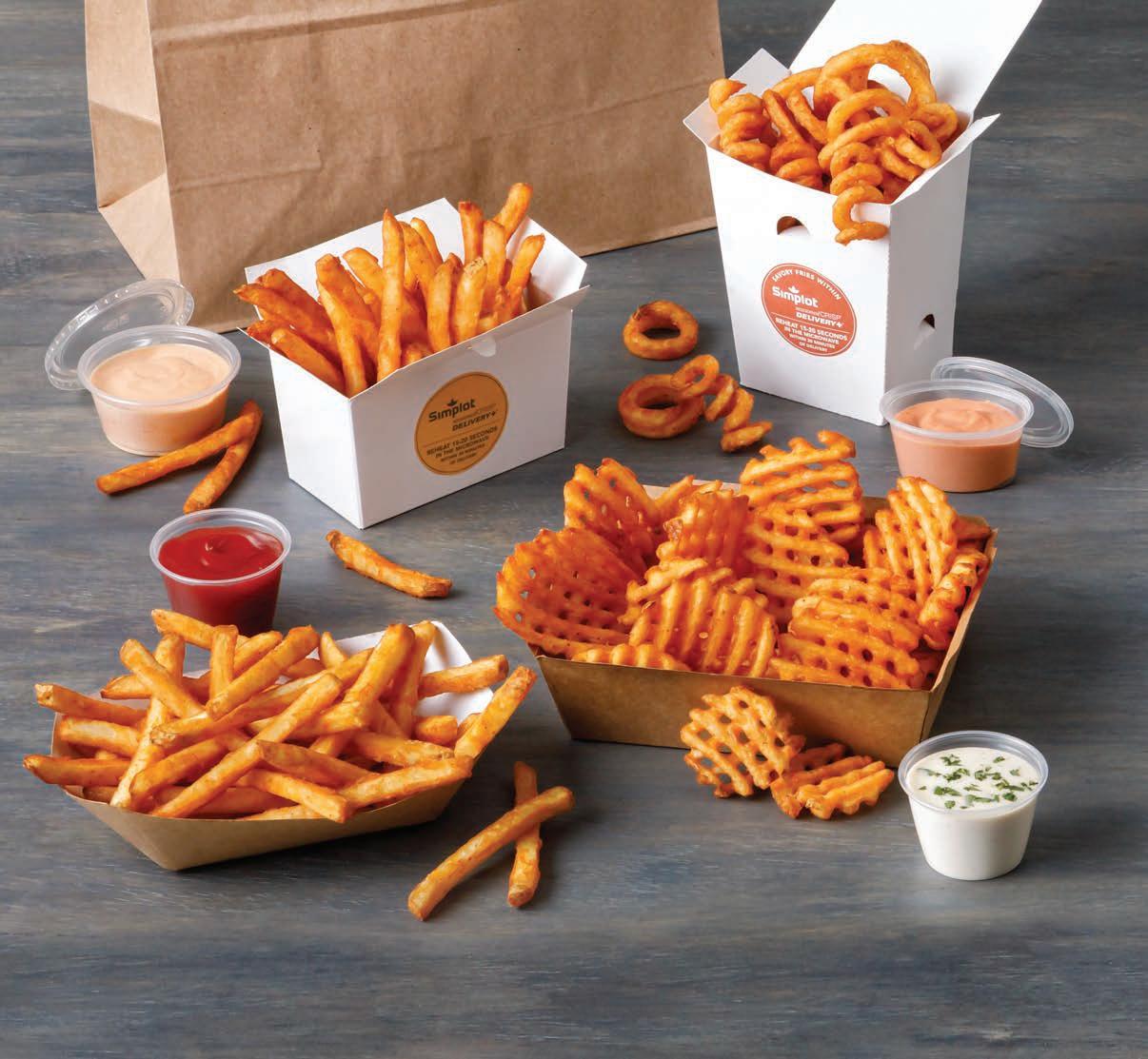
Reheat-able:
Profitable: Great way to increase profits with easy



